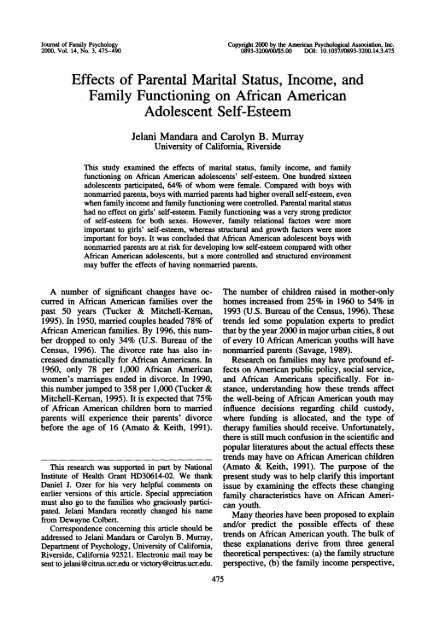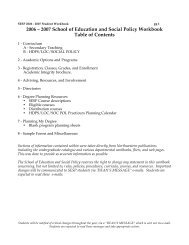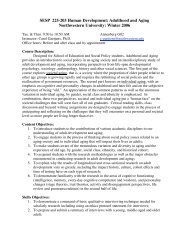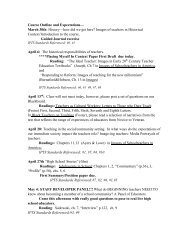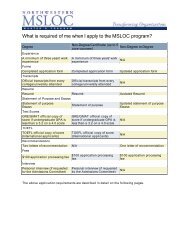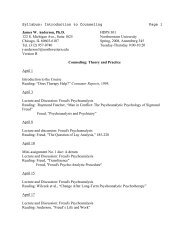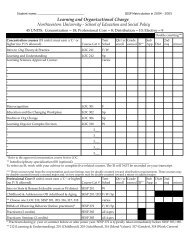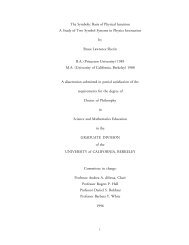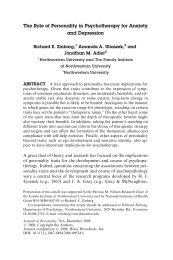Effects of Parental Marital Status, Income, and Family Functioning on ...
Effects of Parental Marital Status, Income, and Family Functioning on ...
Effects of Parental Marital Status, Income, and Family Functioning on ...
Create successful ePaper yourself
Turn your PDF publications into a flip-book with our unique Google optimized e-Paper software.
Journal <str<strong>on</strong>g>of</str<strong>on</strong>g> <str<strong>on</strong>g>Family</str<strong>on</strong>g> Psychology<br />
Copyright 2000 by the American Psychological Associati<strong>on</strong>, Inc.<br />
2000, Vol. 14, No. 3, 475-490 0893-3200/00/$5.00 DOI: 10.1037//0893-3200.14.3.475<br />
<str<strong>on</strong>g>Effects</str<strong>on</strong>g> <str<strong>on</strong>g>of</str<strong>on</strong>g> <str<strong>on</strong>g>Parental</str<strong>on</strong>g> <str<strong>on</strong>g>Marital</str<strong>on</strong>g> <str<strong>on</strong>g>Status</str<strong>on</strong>g>, <str<strong>on</strong>g>Income</str<strong>on</strong>g>, <str<strong>on</strong>g>and</str<strong>on</strong>g><br />
<str<strong>on</strong>g>Family</str<strong>on</strong>g> <str<strong>on</strong>g>Functi<strong>on</strong>ing</str<strong>on</strong>g> <strong>on</strong> African American<br />
Adolescent Self-Esteem<br />
Jelani M<str<strong>on</strong>g>and</str<strong>on</strong>g>ara <str<strong>on</strong>g>and</str<strong>on</strong>g> Carolyn B. Murray<br />
University <str<strong>on</strong>g>of</str<strong>on</strong>g> California, Riverside<br />
This study examined the effects <str<strong>on</strong>g>of</str<strong>on</strong>g> marital status, family income, <str<strong>on</strong>g>and</str<strong>on</strong>g> family<br />
functi<strong>on</strong>ing <strong>on</strong> African American adolescents' self-esteem. One hundred sixteen<br />
adolescents participated, 64% <str<strong>on</strong>g>of</str<strong>on</strong>g> whom were female. Compared with boys with<br />
n<strong>on</strong>married parents, boys with married parents had higher overall self-esteem, even<br />
when family income <str<strong>on</strong>g>and</str<strong>on</strong>g> family functi<strong>on</strong>ing were c<strong>on</strong>trolled. <str<strong>on</strong>g>Parental</str<strong>on</strong>g> marital status<br />
had no effect <strong>on</strong> girls' serf-esteem. <str<strong>on</strong>g>Family</str<strong>on</strong>g> functi<strong>on</strong>ing was a very str<strong>on</strong>g predictor<br />
<str<strong>on</strong>g>of</str<strong>on</strong>g> serf-esteem for both sexes. However, family relati<strong>on</strong>al factors were more<br />
important to girls' self-esteem, whereas structural <str<strong>on</strong>g>and</str<strong>on</strong>g> growth factors were more<br />
important for boys. It was c<strong>on</strong>cluded that African American adolescent boys with<br />
n<strong>on</strong>married parents are at risk for developing low self-esteem compared with other<br />
African American adolescents, but a more c<strong>on</strong>trolled <str<strong>on</strong>g>and</str<strong>on</strong>g> structured envir<strong>on</strong>ment<br />
may buffer the effects <str<strong>on</strong>g>of</str<strong>on</strong>g> having n<strong>on</strong>married parents.<br />
A number <str<strong>on</strong>g>of</str<strong>on</strong>g> significant changes have occurred<br />
in African American families over the<br />
past 50 years (Tucker & MitcheU-Kernan,<br />
1995). In 1950, married couples headed 78% <str<strong>on</strong>g>of</str<strong>on</strong>g><br />
African American families. By 1996, this number<br />
dropped to <strong>on</strong>ly 34% (U.S. Bureau <str<strong>on</strong>g>of</str<strong>on</strong>g> the<br />
Census, 1996). The divorce rate has also increased<br />
dramatically for African Americans. In<br />
1960, <strong>on</strong>ly 78 per 1,000 African American<br />
women's marriages ended in divorce. In 1990,<br />
this number jumped to 358 per 1,000 (Tucker &<br />
Mitchell-Kernan, 1995), It is expected that 75%<br />
<str<strong>on</strong>g>of</str<strong>on</strong>g> African American children born to married<br />
parents will experience their parents' divorce<br />
before the age <str<strong>on</strong>g>of</str<strong>on</strong>g> 16 (Amato & Keith, 1991).<br />
This research was supported in part by Nati<strong>on</strong>al<br />
Institute <str<strong>on</strong>g>of</str<strong>on</strong>g> Health Grant HD30614-02. We thank<br />
Daniel J. Ozer for his very helpful comments <strong>on</strong><br />
earlier versi<strong>on</strong>s <str<strong>on</strong>g>of</str<strong>on</strong>g> this article. Special appreciati<strong>on</strong><br />
must also go to the families who graciously participated.<br />
Jelani M<str<strong>on</strong>g>and</str<strong>on</strong>g>ara recently changed his name<br />
from Dewayne Colbert.<br />
Corresp<strong>on</strong>dence c<strong>on</strong>cerning this article should be<br />
addressed to Jelani M<str<strong>on</strong>g>and</str<strong>on</strong>g>ara or Carolyn B. Murray,<br />
Department <str<strong>on</strong>g>of</str<strong>on</strong>g> Psychology, University <str<strong>on</strong>g>of</str<strong>on</strong>g> California,<br />
Riverside, California 92521. Electr<strong>on</strong>ic mail may be<br />
sent to jelani@citrus.ucr.edu or victory@citrus.ucr.edu.<br />
475<br />
The number <str<strong>on</strong>g>of</str<strong>on</strong>g> children raised in mother-<strong>on</strong>ly<br />
homes increased from 25% in 1960 to 54% in<br />
1993 (U.S. Bureau <str<strong>on</strong>g>of</str<strong>on</strong>g> the Census, 1996). These<br />
trends led some populati<strong>on</strong> experts to predict<br />
that by the year 2000 in major urban cities, 8 out<br />
<str<strong>on</strong>g>of</str<strong>on</strong>g> every 10 African American youths will have<br />
n<strong>on</strong>married parents (Savage, 1989).<br />
Research <strong>on</strong> families may have pr<str<strong>on</strong>g>of</str<strong>on</strong>g>ound effects<br />
<strong>on</strong> American public policy, social service,<br />
<str<strong>on</strong>g>and</str<strong>on</strong>g> African Americans specifically. For instance,<br />
underst<str<strong>on</strong>g>and</str<strong>on</strong>g>ing how these trends affect<br />
the well-being <str<strong>on</strong>g>of</str<strong>on</strong>g> African American youth may<br />
influence decisi<strong>on</strong>s regarding child custody,<br />
where funding is allocated, <str<strong>on</strong>g>and</str<strong>on</strong>g> the type <str<strong>on</strong>g>of</str<strong>on</strong>g><br />
therapy families should receive. Unfortunately,<br />
there is still much c<strong>on</strong>fusi<strong>on</strong> in the scientific <str<strong>on</strong>g>and</str<strong>on</strong>g><br />
popular literatures about the actual effects these<br />
trends may have <strong>on</strong> African American children<br />
(Amato & Keith, 1991). The purpose <str<strong>on</strong>g>of</str<strong>on</strong>g> the<br />
present study was to help clarify this important<br />
issue by examining the effects these changing<br />
family characteristics have <strong>on</strong> African American<br />
youth.<br />
Many theories have been proposed to explain<br />
<str<strong>on</strong>g>and</str<strong>on</strong>g>/or predict the possible effects <str<strong>on</strong>g>of</str<strong>on</strong>g> these<br />
trends <strong>on</strong> African American youth. The bulk <str<strong>on</strong>g>of</str<strong>on</strong>g><br />
these explanati<strong>on</strong>s derive from three general<br />
theoretical perspectives: (a) the family structure<br />
perspective, 0a) the family income perspective,
476 MANDARA AND MURRAY<br />
<str<strong>on</strong>g>and</str<strong>on</strong>g> (c) the family functi<strong>on</strong>ing perspective<br />
(Amato & Keith, 1991; Heiss, 1996).<br />
<str<strong>on</strong>g>Family</str<strong>on</strong>g> Structure Perspective<br />
The historical method <str<strong>on</strong>g>of</str<strong>on</strong>g> studying African<br />
American youth focused <strong>on</strong> the pathological or<br />
disorganizati<strong>on</strong>al aspects <str<strong>on</strong>g>of</str<strong>on</strong>g> the family<br />
(Littlejohn-Blake & Darling, 1993). This focus<br />
led to the family structure perspective, which<br />
essentially states that two-parent homes facilitate<br />
a better envir<strong>on</strong>ment for youths' well-being<br />
compared with single-parent homes (Erel &<br />
Burman, 1995). This theory suggests that adolescents<br />
<str<strong>on</strong>g>and</str<strong>on</strong>g> children from single-parent homes<br />
are severely h<str<strong>on</strong>g>and</str<strong>on</strong>g>icapped. Accordingly, this<br />
perspective argues that all things being equal,<br />
the most salient effect <str<strong>on</strong>g>of</str<strong>on</strong>g> single-parent homes<br />
<strong>on</strong> children is the lack <str<strong>on</strong>g>of</str<strong>on</strong>g> the physical presence<br />
<str<strong>on</strong>g>of</str<strong>on</strong>g> two parents. Often the methodology employed<br />
either marital status or some other identifier<br />
<str<strong>on</strong>g>of</str<strong>on</strong>g> two parents in the home as the main<br />
independent variable for predicting outcomes<br />
(Florsheim, Tolan, & Gorman-Smith, 1998).<br />
Recent studies <str<strong>on</strong>g>of</str<strong>on</strong>g> African American populati<strong>on</strong>s<br />
indicated that children from two-parent<br />
homes do better than children from singleparent<br />
homes <strong>on</strong> a variety <str<strong>on</strong>g>of</str<strong>on</strong>g> social indicators<br />
(Coley, 1998; McLeod, Kruttschnitt, & Dornfeld,<br />
1994; Teachman, Day, Paasch, Carver, &<br />
Call, 1998). For instance, McLanahan (1985)<br />
found that African American children living<br />
with <strong>on</strong>e parent were less likely to be in school<br />
at age 17 than their two-parent counterparts. In<br />
another study, a significant positive relati<strong>on</strong>ship<br />
was found between father presence <str<strong>on</strong>g>and</str<strong>on</strong>g> selfesteem<br />
(Alst<strong>on</strong> & Williams, 1982). Fatherpresent<br />
youths also exhibited str<strong>on</strong>ger scholastic<br />
achievement <str<strong>on</strong>g>and</str<strong>on</strong>g> more stable peer relati<strong>on</strong>s.<br />
The researchers c<strong>on</strong>cluded that the father-s<strong>on</strong><br />
relati<strong>on</strong>ship facilitated the adopti<strong>on</strong> <str<strong>on</strong>g>of</str<strong>on</strong>g> an adequate<br />
self-c<strong>on</strong>cept because boys were able to<br />
model their fathers. Another recent study (Paschall,<br />
Ennett, & Flewelling, 1996) found that<br />
living in a single-parent home was a significant<br />
risk factor for violent behavior in African<br />
American children. Another study <str<strong>on</strong>g>of</str<strong>on</strong>g> 107 lowincome<br />
African American children found that<br />
children whose fathers were present had significantly<br />
higher adaptive functi<strong>on</strong>ing scores than<br />
did children whose fathers did not live with<br />
them (Dunn & Tucker, 1993). A recent l<strong>on</strong>gitudinal<br />
study found that African American children<br />
in two-parent homes had significantly<br />
higher math <str<strong>on</strong>g>and</str<strong>on</strong>g> reading scores <str<strong>on</strong>g>and</str<strong>on</strong>g> lower behavioral<br />
problems than did children in singleparent<br />
homes. The results held up over a 4-year<br />
period for both older <str<strong>on</strong>g>and</str<strong>on</strong>g> younger siblings in the<br />
sample (Teachman et al., 1998).<br />
However, some researchers highlighted the<br />
fact that not all studies show advantages for<br />
two-parent homes (Heiss, 1996; Phillips & Asbury,<br />
1993). Also, even for the studies that do,<br />
the effect sizes may not be large enough to be<br />
socially relevant (Heiss, 1996). Many researchers<br />
also argued that the c<strong>on</strong>sequences <str<strong>on</strong>g>of</str<strong>on</strong>g> singleparent<br />
homes were mainly related to the ec<strong>on</strong>omic<br />
deprivati<strong>on</strong> <str<strong>on</strong>g>of</str<strong>on</strong>g> the single-parent home<br />
(e.g., McLeod et al., 1994; A. N. Wils<strong>on</strong>, 1979),<br />
<str<strong>on</strong>g>and</str<strong>on</strong>g> others argued that the studies did not account<br />
for important aspects <str<strong>on</strong>g>of</str<strong>on</strong>g> family functi<strong>on</strong>ing<br />
or extended kin (Dancy & H<str<strong>on</strong>g>and</str<strong>on</strong>g>al, 1984;<br />
Logan, 1996; L<strong>on</strong>g, 1986; Partridge & Kotler,<br />
1987; Scott & Black, 1989). For instance,<br />
Boyd-Franklin (1989) argued that the strength<br />
<str<strong>on</strong>g>of</str<strong>on</strong>g> flexible family roles in African American<br />
families has not been taken into c<strong>on</strong>siderati<strong>on</strong>.<br />
In other words, many researchers have been<br />
interested in knowing whether the observed effects<br />
<str<strong>on</strong>g>of</str<strong>on</strong>g> family structure persisted when important<br />
sociodemographic <str<strong>on</strong>g>and</str<strong>on</strong>g> envir<strong>on</strong>mental variables,<br />
such as family income <str<strong>on</strong>g>and</str<strong>on</strong>g> family<br />
functi<strong>on</strong>ing were c<strong>on</strong>trolled (Demo & Acock,<br />
1988; Partridge & Kotler, 1987). These assumpti<strong>on</strong>s<br />
<str<strong>on</strong>g>and</str<strong>on</strong>g> questi<strong>on</strong>s led to alternative theoretical<br />
perspectives.<br />
<str<strong>on</strong>g>Family</str<strong>on</strong>g> <str<strong>on</strong>g>Income</str<strong>on</strong>g> Perspective<br />
The ec<strong>on</strong>omic deprivati<strong>on</strong> perspective has<br />
been given enormous attenti<strong>on</strong> by researchers <str<strong>on</strong>g>of</str<strong>on</strong>g><br />
African American family processes (reviewed<br />
in Taylor, Chatters, Tucker, & Lewis, 1990),<br />
specifically with regard to single-mother homes<br />
(McLanahan, 1985; Wils<strong>on</strong>, 1979). Fifty percent<br />
<str<strong>on</strong>g>of</str<strong>on</strong>g> African American female-headed families<br />
live below the poverty line, which makes<br />
them the most impoverished group in America<br />
(Taylor et al., 1990).<br />
The prop<strong>on</strong>ents <str<strong>on</strong>g>of</str<strong>on</strong>g> the ec<strong>on</strong>omic deprivati<strong>on</strong><br />
perspective argued that the potential effects <str<strong>on</strong>g>of</str<strong>on</strong>g><br />
single parents is not due to the physical absence<br />
<str<strong>on</strong>g>of</str<strong>on</strong>g> <strong>on</strong>e parent but to the absence <str<strong>on</strong>g>of</str<strong>on</strong>g> the ec<strong>on</strong>omic<br />
resources generated by the absent parent. Therefore,<br />
the effects <str<strong>on</strong>g>of</str<strong>on</strong>g> marital status <strong>on</strong> child wellbeing<br />
will be reduced when income is statistically<br />
c<strong>on</strong>trolled or when families are matched<br />
<strong>on</strong> income level. For instance, McLeod et al.
SPECIAL ISSUE: FAMILY AND ADOLESCENT SELF-ESTEEM 477<br />
(1994) argued that parents who experienced income<br />
loss became more rejecting <str<strong>on</strong>g>of</str<strong>on</strong>g> their children<br />
<str<strong>on</strong>g>and</str<strong>on</strong>g> that their children were at risk for<br />
developing feelings <str<strong>on</strong>g>of</str<strong>on</strong>g> inadequacy associated<br />
with parental rejecti<strong>on</strong>. However, the empirical<br />
research <strong>on</strong> the effects <str<strong>on</strong>g>of</str<strong>on</strong>g> income has not been<br />
adequately tested (Amato & Keith, 1991) nor<br />
has it c<strong>on</strong>sistently supported these assumpti<strong>on</strong>s<br />
for African American children (Heiss, 1996).<br />
<str<strong>on</strong>g>Family</str<strong>on</strong>g> <str<strong>on</strong>g>Functi<strong>on</strong>ing</str<strong>on</strong>g> Perspective<br />
The limitati<strong>on</strong>s <str<strong>on</strong>g>and</str<strong>on</strong>g> small effect sizes found<br />
by family structure studies, as well as the income<br />
perspectives, led many researchers to criticize<br />
both approaches for several reas<strong>on</strong>s (e.g.,<br />
Murray & Fairchild, 1989; Scott & Black,<br />
1989). For instance, M. N. Wils<strong>on</strong> (1992) argued<br />
that the major problem with pathological-based<br />
studies was not the harsh facts that<br />
described an important number <str<strong>on</strong>g>of</str<strong>on</strong>g> African<br />
American families but the failure to study how<br />
these families survived in extremely adverse<br />
c<strong>on</strong>diti<strong>on</strong>s.<br />
The family structure model fails to c<strong>on</strong>sider<br />
aspects <str<strong>on</strong>g>of</str<strong>on</strong>g> parent-child relati<strong>on</strong>ships (McAdoo,<br />
1997; Partridge & Kotler, 1987) <str<strong>on</strong>g>and</str<strong>on</strong>g> socializati<strong>on</strong><br />
processes within African American families<br />
(M. N. Wils<strong>on</strong>, 1992). The family functi<strong>on</strong>ing<br />
model suggests that children may be better<br />
<str<strong>on</strong>g>of</str<strong>on</strong>g>f in a cohesive single-parent home than in a<br />
c<strong>on</strong>flictive two-parent home (L<strong>on</strong>g, 1986).<br />
Research <strong>on</strong> the effects <str<strong>on</strong>g>of</str<strong>on</strong>g> family functi<strong>on</strong>ing<br />
quality <strong>on</strong> African American children has generally<br />
been very supportive <str<strong>on</strong>g>of</str<strong>on</strong>g> the family functi<strong>on</strong>ing<br />
theory (Cooper, Holman, & Braithwaite,<br />
1983; Heiss, 1996). Dancy <str<strong>on</strong>g>and</str<strong>on</strong>g> H<str<strong>on</strong>g>and</str<strong>on</strong>g>al (1984)<br />
found that family-envir<strong>on</strong>ment quality significantly<br />
predicted African American adolescents'<br />
percepti<strong>on</strong>s <str<strong>on</strong>g>of</str<strong>on</strong>g> family climate, psychological adjustment,<br />
<str<strong>on</strong>g>and</str<strong>on</strong>g> grade point average. Heiss (1996)<br />
also found that family structure had weak effects<br />
<strong>on</strong> academic variables for African American<br />
adolescents, but parental involvement had<br />
a very str<strong>on</strong>g effect <strong>on</strong> the same variables.<br />
<str<strong>on</strong>g>Family</str<strong>on</strong>g> structure effects may be limited to<br />
boys as well (Stephens & Day, 1979; Stevens<strong>on</strong><br />
& Black, 1988). Numerous studies showed that<br />
fathers <str<strong>on</strong>g>and</str<strong>on</strong>g> mothers treated their girls <str<strong>on</strong>g>and</str<strong>on</strong>g> boys<br />
differently (Copel<str<strong>on</strong>g>and</str<strong>on</strong>g>, 1985; Jacks<strong>on</strong>, 1993;<br />
Jenkins & Guidubaldi, 1997; Leve & Fagot,<br />
1997; Mott, 1994; Seigal, 1987; Starrels, 1994).<br />
M. N. Wils<strong>on</strong> (1992) found differences in children's<br />
<str<strong>on</strong>g>and</str<strong>on</strong>g> mothers' percepti<strong>on</strong>s regarding the<br />
African American fathers' socializing strategies<br />
<str<strong>on</strong>g>of</str<strong>on</strong>g> their girls <str<strong>on</strong>g>and</str<strong>on</strong>g> boys. Specifically, mothers,<br />
gr<str<strong>on</strong>g>and</str<strong>on</strong>g>mothers, daughters, <str<strong>on</strong>g>and</str<strong>on</strong>g> s<strong>on</strong>s perceived<br />
the fathers <str<strong>on</strong>g>of</str<strong>on</strong>g> s<strong>on</strong>s as using more c<strong>on</strong>trolling,<br />
dem<str<strong>on</strong>g>and</str<strong>on</strong>g>ing, <str<strong>on</strong>g>and</str<strong>on</strong>g> supporting parental behaviors<br />
than was perceived for fathers <str<strong>on</strong>g>of</str<strong>on</strong>g> daughters.<br />
Fathers <str<strong>on</strong>g>of</str<strong>on</strong>g> s<strong>on</strong>s were also perceived as more<br />
involved with their children than were fathers <str<strong>on</strong>g>of</str<strong>on</strong>g><br />
daughters. Other studies showed that fathers<br />
hold more masculine gender role attitudes toward<br />
their s<strong>on</strong>s <str<strong>on</strong>g>and</str<strong>on</strong>g> more feminine attitudes<br />
toward their daughters (Price-B<strong>on</strong>ham & Skeen,<br />
1982). In general, fathers appeared to be more<br />
strict with their boys than were mothers <str<strong>on</strong>g>and</str<strong>on</strong>g><br />
more strict with boys than they were with girls.<br />
Therefore, the effects <str<strong>on</strong>g>of</str<strong>on</strong>g> parental marital status<br />
may be more apparent for boys than for girls.<br />
Self-Esteem<br />
Self-esteem generally c<strong>on</strong>notes the positive<br />
or negative value <strong>on</strong>e places <strong>on</strong> <strong>on</strong>e's own<br />
attributes (Freshbach & Weiner, 1991). Global<br />
<str<strong>on</strong>g>and</str<strong>on</strong>g> domain-specific self-esteem has been<br />
shown to influence a significant number <str<strong>on</strong>g>of</str<strong>on</strong>g> psychological<br />
<str<strong>on</strong>g>and</str<strong>on</strong>g> behavioral variables in children<br />
<str<strong>on</strong>g>and</str<strong>on</strong>g> adolescents. Some authors questi<strong>on</strong>ed the<br />
importance <str<strong>on</strong>g>of</str<strong>on</strong>g> self-esteem to African American<br />
populati<strong>on</strong>s, because it was shown to have negligible<br />
effects <strong>on</strong> academic performance (Demo<br />
& Parker, 1987). However, many studies found<br />
that self-esteem is crucially related to important<br />
outcome measures <str<strong>on</strong>g>of</str<strong>on</strong>g> well-being for African<br />
Americans. For instance, self-esteem has been<br />
negatively correlated with smoking frequency<br />
(Botvin et al., 1993), suppressed anger (Johns<strong>on</strong><br />
& Greene, 1991), drug abuse (Unger, Kipke,<br />
Sim<strong>on</strong>, M<strong>on</strong>tgomery, & Johns<strong>on</strong>, 1997), <str<strong>on</strong>g>and</str<strong>on</strong>g><br />
depressi<strong>on</strong> symptomatology (Caldwell, Ant<strong>on</strong>ucci,<br />
Jacks<strong>on</strong>, Wolford, & Os<str<strong>on</strong>g>of</str<strong>on</strong>g>sky, 1997) in<br />
African American children <str<strong>on</strong>g>and</str<strong>on</strong>g> adolescents.<br />
Another recent study found that drinking level<br />
was negatively related to self-esteem in African<br />
American college students who had alcoholic<br />
parents (Rodney & Rodney, 1996). Thus, selfesteem<br />
is an important index <str<strong>on</strong>g>of</str<strong>on</strong>g> African American<br />
adolescents' well-being.<br />
In the present study, we examined four hypotheses<br />
suggested by the three major theoretical<br />
perspectives <str<strong>on</strong>g>and</str<strong>on</strong>g> recent studies <str<strong>on</strong>g>of</str<strong>on</strong>g> gender<br />
effects <strong>on</strong> self-esteem. The family structure perspective<br />
suggested the first two. First, we predicted<br />
that parental marital status would affect<br />
the self-esteem <str<strong>on</strong>g>of</str<strong>on</strong>g> African American boys, but
SPECIAL ISSUE: FAMILY AND ADOLESCENT SELF-ESTEEM 479<br />
<str<strong>on</strong>g>of</str<strong>on</strong>g> the subscales for other samples, see O'Bden <str<strong>on</strong>g>and</str<strong>on</strong>g><br />
Epstein (1988).<br />
FES.The FES is a 90-item true-or-false test that<br />
assesses percepti<strong>on</strong>s <str<strong>on</strong>g>of</str<strong>on</strong>g> family envir<strong>on</strong>ment across 10<br />
subscales. The subscales are factors <str<strong>on</strong>g>of</str<strong>on</strong>g> three family<br />
envir<strong>on</strong>ment dimensi<strong>on</strong>s. The relati<strong>on</strong>ship dimensi<strong>on</strong><br />
c<strong>on</strong>sists <str<strong>on</strong>g>of</str<strong>on</strong>g> the Cohesi<strong>on</strong>, C<strong>on</strong>flict, <str<strong>on</strong>g>and</str<strong>on</strong>g> Expressiveness<br />
subscales. The pers<strong>on</strong>al growth dimensi<strong>on</strong> c<strong>on</strong>sists<br />
<str<strong>on</strong>g>of</str<strong>on</strong>g> the Independence-Aut<strong>on</strong>omy, Achievement<br />
Orientati<strong>on</strong>, Intellectual-Cultural Orientati<strong>on</strong>, Active<br />
Recreati<strong>on</strong>al Orientati<strong>on</strong>, <str<strong>on</strong>g>and</str<strong>on</strong>g> Moral-Religious subscales.<br />
The systems maintenance dimensi<strong>on</strong> c<strong>on</strong>sists<br />
<str<strong>on</strong>g>of</str<strong>on</strong>g> the last two subscales, <str<strong>on</strong>g>Family</str<strong>on</strong>g> Organizati<strong>on</strong> <str<strong>on</strong>g>and</str<strong>on</strong>g><br />
C<strong>on</strong>trol.<br />
The norms for the FES were derived from 285<br />
families sampled from predominately middle <str<strong>on</strong>g>and</str<strong>on</strong>g> upper<br />
socioec<strong>on</strong>omic status European American families.<br />
The 10 subscales show intercorrelati<strong>on</strong>s averaging<br />
around .20 <str<strong>on</strong>g>and</str<strong>on</strong>g> exhibit adequate internal<br />
c<strong>on</strong>sistency (Cr<strong>on</strong>bach's alphas range from .64 to<br />
.79). Eight-week test-retest reliabilities ranged from<br />
.68 to .86 (Moos, 1990). For the present sample,<br />
alphas ranged between .20 <str<strong>on</strong>g>and</str<strong>on</strong>g> .75. A 1-year lag<br />
test-retest showed an average reliability <str<strong>on</strong>g>of</str<strong>on</strong>g> .52. The<br />
FES has been used <strong>on</strong> African American samples<br />
many times <str<strong>on</strong>g>and</str<strong>on</strong>g> has c<strong>on</strong>sistently shown excellent<br />
predictive validity (Dancy & H<str<strong>on</strong>g>and</str<strong>on</strong>g>al, 1984).<br />
Results<br />
Overview <str<strong>on</strong>g>and</str<strong>on</strong>g> Preliminary Analyses<br />
The results <str<strong>on</strong>g>of</str<strong>on</strong>g> this study are presented in two<br />
secti<strong>on</strong>s according to the ordering <str<strong>on</strong>g>of</str<strong>on</strong>g> the hypotheses.<br />
The multivariate effects <str<strong>on</strong>g>of</str<strong>on</strong>g> family<br />
structure, income, <str<strong>on</strong>g>and</str<strong>on</strong>g> functi<strong>on</strong>ing <strong>on</strong> selfesteem<br />
were examined for the total sample <str<strong>on</strong>g>and</str<strong>on</strong>g><br />
then for boys <str<strong>on</strong>g>and</str<strong>on</strong>g> girls separately. The next<br />
secti<strong>on</strong> <str<strong>on</strong>g>of</str<strong>on</strong>g> the results compared the effects <str<strong>on</strong>g>of</str<strong>on</strong>g><br />
family structure <str<strong>on</strong>g>and</str<strong>on</strong>g> family functi<strong>on</strong>ing by two<br />
different methods.<br />
Before tests <str<strong>on</strong>g>of</str<strong>on</strong>g> the hypotheses were performed,<br />
the variables were screened for multivariate<br />
assumpti<strong>on</strong>s according to the procedures<br />
outlined by Tabachnik <str<strong>on</strong>g>and</str<strong>on</strong>g> Fidell (1996). The<br />
Kolmogorov-Smirnov statistic <str<strong>on</strong>g>and</str<strong>on</strong>g> a Lilliefors<br />
significance test assessed univariate normality.<br />
A Mahalanobis distance measure assessed outliers.<br />
The variables were also examined for boys<br />
<str<strong>on</strong>g>and</str<strong>on</strong>g> girls separately. Because <str<strong>on</strong>g>of</str<strong>on</strong>g> the presence <str<strong>on</strong>g>of</str<strong>on</strong>g><br />
outliers <str<strong>on</strong>g>and</str<strong>on</strong>g> slightly skewed distributi<strong>on</strong>s, we<br />
performed square, square root, or logarithmic<br />
power transformati<strong>on</strong>s <strong>on</strong> the following variables:<br />
Global Self-Esteem, Self-C<strong>on</strong>trol, Body<br />
<str<strong>on</strong>g>Functi<strong>on</strong>ing</str<strong>on</strong>g>, <str<strong>on</strong>g>and</str<strong>on</strong>g> the composite total selfesteem.<br />
In all subsequent analyses using these<br />
variables, the transformed versi<strong>on</strong>s were compared<br />
with the untransformed versi<strong>on</strong>s. There<br />
were no differences in multivariate or univariate<br />
results when the transformed or untransformed<br />
versi<strong>on</strong>s were used. Therefore, the untransformed<br />
variables were used in all analyses.<br />
<str<strong>on</strong>g>Family</str<strong>on</strong>g> Structure <str<strong>on</strong>g>Effects</str<strong>on</strong>g> <strong>on</strong> Self-Esteem<br />
The first hypothesis predicted that male adolescents<br />
in married two-parent homes would<br />
have higher overall self-esteem compared with<br />
male adolescents from single-parent homes. No<br />
differences were expected between groups <str<strong>on</strong>g>of</str<strong>on</strong>g><br />
female adolescents. To test this hypothesis, we<br />
computed a 2 × 2 (<str<strong>on</strong>g>Family</str<strong>on</strong>g> Structure × Gender)<br />
multivariate analysis <str<strong>on</strong>g>of</str<strong>on</strong>g> variance (MANOVA)<br />
<strong>on</strong> the 10 self-esteem subscales. The multivariate<br />
effect <str<strong>on</strong>g>of</str<strong>on</strong>g> family structure was n<strong>on</strong>significant,<br />
Wilks's lambda = .899, F(10, 88) = .986,<br />
712 = .101, but gender had a significant effect,<br />
Wilks's lambda = .741, F(10, 88) = 3.07, p <<br />
.01, rl 2 = .259, indicating differences in selfesteem<br />
between girls <str<strong>on</strong>g>and</str<strong>on</strong>g> boys. The univariate<br />
analyses <str<strong>on</strong>g>of</str<strong>on</strong>g> variance (ANOVAs) revealed that<br />
girls were significantly lower in defensiveness,<br />
F(I, 97) = 6.66, p < .01, ~2 = .245. Defensiveness<br />
was reversed, so that the higher the<br />
score, the less defensive the participant was.<br />
Boys were significantly higher in percepti<strong>on</strong>s <str<strong>on</strong>g>of</str<strong>on</strong>g><br />
body functi<strong>on</strong>ing, F(1, 97) = 3.97, p < .05,<br />
~2 = . 196. The multivariate interacti<strong>on</strong> between<br />
family structure <str<strong>on</strong>g>and</str<strong>on</strong>g> gender was also n<strong>on</strong>significant,<br />
Wilks's lambda = .899, F(10, 88) = .984,<br />
~12 = .101, indicating that the effects <str<strong>on</strong>g>of</str<strong>on</strong>g> marital<br />
status were not significantly different for boys<br />
<str<strong>on</strong>g>and</str<strong>on</strong>g> girls.<br />
We then computed MANOVAs separately<br />
for boys <str<strong>on</strong>g>and</str<strong>on</strong>g> girls. Table 1 presents the<br />
means, st<str<strong>on</strong>g>and</str<strong>on</strong>g>ard deviati<strong>on</strong>s, univariate tests <str<strong>on</strong>g>of</str<strong>on</strong>g><br />
significance, <str<strong>on</strong>g>and</str<strong>on</strong>g> effect sizes <str<strong>on</strong>g>of</str<strong>on</strong>g> the selfesteem<br />
dimensi<strong>on</strong>s for boys <str<strong>on</strong>g>and</str<strong>on</strong>g> girls separately.<br />
For girls, the MANOVA was n<strong>on</strong>significant,<br />
Wilks's lambda = .955, F(10, 45) = .213,<br />
as were all the univariate tests. For boys, this<br />
was not the case; family structure had a significant<br />
multivariate effect, Wilks's lambda =<br />
.610, F(10, 34) = 2.17, p < .05, rl 2 = .390. As<br />
can be seen in Table 1, boys with n<strong>on</strong>married<br />
parents were found to have significantly lower<br />
self-c<strong>on</strong>trol, feelings <str<strong>on</strong>g>of</str<strong>on</strong>g> pers<strong>on</strong>al power, selfcompetence,<br />
<str<strong>on</strong>g>and</str<strong>on</strong>g> percepti<strong>on</strong>s <str<strong>on</strong>g>of</str<strong>on</strong>g> body functi<strong>on</strong>ing<br />
compared with boys who had married parents.<br />
Although not used in the MANOVA, boys
480 MANDARA AND MURRAY<br />
Table 1<br />
Mean Scores <str<strong>on</strong>g>and</str<strong>on</strong>g> St<str<strong>on</strong>g>and</str<strong>on</strong>g>ard Deviati<strong>on</strong>s for Measures <str<strong>on</strong>g>of</str<strong>on</strong>g> Self-Esteem for Boys <str<strong>on</strong>g>and</str<strong>on</strong>g> Girls<br />
by <str<strong>on</strong>g>Parental</str<strong>on</strong>g> <str<strong>on</strong>g>Marital</str<strong>on</strong>g> <str<strong>on</strong>g>Status</str<strong>on</strong>g><br />
Boys<br />
<str<strong>on</strong>g>Parental</str<strong>on</strong>g> marital status<br />
Girls<br />
<str<strong>on</strong>g>Parental</str<strong>on</strong>g> marital status<br />
Married Single Married Single<br />
Measure <str<strong>on</strong>g>of</str<strong>on</strong>g> (n = 23) (n = 23) (n = 29) (n = 27)<br />
self-esteem M SD M SD F(1, 43) ~1 M SD M SD F(1, 54) 1/<br />
Total 3.60 0.37 3.32 0.35 6.72* .368 3.57 0.47 3.51 0.40 0.27 .072<br />
Global 3.88 0.62 3.47 0.80 3.48 .274 3.79 0.83 3.65 0.84 0.40 .086<br />
Self-Approval 3.50 0.48 3.43 0.43 0.21 .070 3.65 0.55 3.57 0.69 0.23 .066<br />
Lovability 3.50 0.57 3.31 0.64 1.09 .157 3.59 0.65 3.56 0.69 0.04 .028<br />
Likability 3.67 0.52 3.43 0.50 2.27 .224 3.66 0.42 3.56 0.69 1.00 .135<br />
Self-C<strong>on</strong>trol 3.79 0.48 3.30 0.60 9.16"* .419 3.68 0.73 3.55 0.53 0.59 .105<br />
Self-Identity 3.60 0.54 3.41 0.61 1.10 .158 3.59 0.71 3.52 0.55 0.18 .059<br />
Power 3.83 0.55 3.44 0.37 7.35* .382 3.79 0.66 3.81 0.49 0.02 -.023<br />
Competence 3.73 0.44 3.35 0.50 7.23* .380 3.69 0.40 3.70 0.47 0.00 -.010<br />
Defensiveness 2.55 0.41 2.53 0.38 0.02 .021 2.79 0.56 2.76 0.39 0.02 .023<br />
Body <str<strong>on</strong>g>Functi<strong>on</strong>ing</str<strong>on</strong>g> 3.94 0.57 3.47 0.58 7.57* .387 3.47 0.70 3.45 0.57 0.02 .019<br />
*p
SPECIAL ISSUE: FAMILY AND ADOLESCENT SELF-ESTEEM 481<br />
.8<br />
.6<br />
, i I E<br />
.4<br />
oo%<br />
~N -.2<br />
/il<br />
L<br />
I ,<br />
I<br />
i<br />
I<br />
m<br />
[] Boys: married<br />
m • u |<br />
• Gids: married<br />
e- -.6,<br />
-.8<br />
/ii/m<br />
i<br />
• Boys: not married<br />
& Girls: not married<br />
Self-esteem Dimensi<strong>on</strong>s<br />
Figure 1. Mean seE-esteem pr<str<strong>on</strong>g>of</str<strong>on</strong>g>ile for boys <str<strong>on</strong>g>and</str<strong>on</strong>g> girls by parental marital status. Married = parents are<br />
married; not married = parents are not married.<br />
did emerge. Because these results may help<br />
highlight the mechanism by which family structure<br />
affects boys' self-esteem, <str<strong>on</strong>g>and</str<strong>on</strong>g> because the<br />
relatively small sample size significantly re-<br />
duced the power <str<strong>on</strong>g>of</str<strong>on</strong>g> the MANOVA, these results<br />
are discussed.<br />
Boys with married parents reported higher<br />
levels <str<strong>on</strong>g>of</str<strong>on</strong>g> achievement orientati<strong>on</strong> in their homes<br />
Table 2<br />
Mean Scores <str<strong>on</strong>g>and</str<strong>on</strong>g> St<str<strong>on</strong>g>and</str<strong>on</strong>g>ard Deviati<strong>on</strong>s for Measures <str<strong>on</strong>g>of</str<strong>on</strong>g> <str<strong>on</strong>g>Family</str<strong>on</strong>g> Envir<strong>on</strong>ment for Boys <str<strong>on</strong>g>and</str<strong>on</strong>g> Girls<br />
by <str<strong>on</strong>g>Parental</str<strong>on</strong>g> <str<strong>on</strong>g>Marital</str<strong>on</strong>g> <str<strong>on</strong>g>Status</str<strong>on</strong>g><br />
Measure <str<strong>on</strong>g>of</str<strong>on</strong>g><br />
family<br />
envir<strong>on</strong>ment<br />
Boys<br />
<str<strong>on</strong>g>Parental</str<strong>on</strong>g> marital status<br />
Married Single<br />
(n = 23) (n = 22)<br />
M SD M SD<br />
Girls<br />
<str<strong>on</strong>g>Parental</str<strong>on</strong>g> marital status<br />
Married Single<br />
(n = 28) (n = 27)<br />
F(1, 43) ~i M SD M SD F(1, 54) rl<br />
Cohesi<strong>on</strong> 1.67 0.21 1.62 0.24 0.49 .107 1.69 0.21 1.67 0.26 0.11 .046<br />
Achievement 1.78 0.15 1.66 0.16 6.48** .362 1.73 0.16 1.74 0.15 0.04 -.030<br />
Expressiveness 1.41 0.16 1.54 0.20 5.63* -.340 1.52 0.19 1.47 0.19 0.99 .135<br />
Independence<br />
Intellectual<br />
1.58<br />
1.57<br />
0.14<br />
0.24<br />
1.57<br />
1.58<br />
0.15<br />
0.15<br />
0.04<br />
0.00<br />
.032<br />
-.015<br />
1.55<br />
1.60<br />
0.16<br />
0.26<br />
1.54 0.15<br />
1.61 0.20<br />
0.05<br />
0.03<br />
.032<br />
-.025<br />
Recreati<strong>on</strong> 1.65 0.19 1.65 0.24 0.00 .013 1.61 0.25 1.61 0.26 0.00 -.005<br />
Moral 1.73 0.15 1.68 0.21 1.05 .155 1.75 0.21 1.67 0.18 2.48 .209<br />
Organizati<strong>on</strong> 1.70 0.19 1.59 0.20 3.41 .271 1.66 0.22 1.62 0.21 0.35 .081<br />
C<strong>on</strong>trol 1.71 0.18 1.62 0.18 2.81 .248 1.61 0.15 1.69 0.15 3.45 -.245<br />
C<strong>on</strong>flict 1.37 0.20 1.47 0.23 2.10 -.216 1.38 0.25 1.47 0.26 1.63 -.171<br />
*p
482 MANDARA AND MURRAY<br />
compared with boys in noumarried-parent<br />
homes (rpb = .362). However, boys with married<br />
parents reported lower levels <str<strong>on</strong>g>of</str<strong>on</strong>g> family<br />
expressiveness compared with boys in singleparent<br />
homes (rpb = .340). These trends suggest<br />
that the percepti<strong>on</strong>s <str<strong>on</strong>g>of</str<strong>on</strong>g> family functi<strong>on</strong>ing may<br />
differ according to marital status for boys, but<br />
the data are not c<strong>on</strong>clusive.<br />
<str<strong>on</strong>g>Income</str<strong>on</strong>g> <str<strong>on</strong>g>Effects</str<strong>on</strong>g><br />
To examine the effects <str<strong>on</strong>g>of</str<strong>on</strong>g> income <strong>on</strong> selfesteem,<br />
we computed a general linear model<br />
multivariate regressi<strong>on</strong> analysis using income,<br />
gender, <str<strong>on</strong>g>and</str<strong>on</strong>g> the interacti<strong>on</strong> as predictors <strong>on</strong> the<br />
10 self-esteem subscales. The general linear<br />
model multivariate procedure provides regressi<strong>on</strong><br />
analysis for multiple dependent variables.<br />
The results are interpreted in the same fashi<strong>on</strong><br />
as a categorical predictor MANOVA (SPSS,<br />
1997). There was a n<strong>on</strong>significant effect <str<strong>on</strong>g>of</str<strong>on</strong>g> income<br />
<strong>on</strong> self-esteem, Wilks's lambda = .840,<br />
F(10, 88) = 1.64, */2 = .160, whereas gender<br />
c<strong>on</strong>tinued to have a significant effect <strong>on</strong> selfesteem.<br />
The interacti<strong>on</strong> <str<strong>on</strong>g>of</str<strong>on</strong>g> income <str<strong>on</strong>g>and</str<strong>on</strong>g> gender<br />
was also n<strong>on</strong>significant, Wilks's lambda =<br />
.926, F(10, 86) = .68, */2 = .074. The univariate<br />
tests revealed that family income significantly<br />
predicted the self-esteem dimensi<strong>on</strong>s <str<strong>on</strong>g>of</str<strong>on</strong>g><br />
lovability, F(1, 97) = 3.93, p < .05, 72 = .04;<br />
likability, F(1, 97) = 6.33, p < .01, */~ = .062;<br />
<str<strong>on</strong>g>and</str<strong>on</strong>g> self-c<strong>on</strong>trol, F(1, 97) = 5.08, p < .05, -02 =<br />
.04. The results imply that income may be positively<br />
associated with some self-esteem factors<br />
in African American adolescents, but c<strong>on</strong>clusive<br />
evidence can not be determined from this<br />
sample. The same analysis was computed for<br />
girls <str<strong>on</strong>g>and</str<strong>on</strong>g> boys separately, <str<strong>on</strong>g>and</str<strong>on</strong>g> the multivariate<br />
effect <str<strong>on</strong>g>of</str<strong>on</strong>g> income was similar <str<strong>on</strong>g>and</str<strong>on</strong>g> n<strong>on</strong>significant<br />
for both girls <str<strong>on</strong>g>and</str<strong>on</strong>g> boys.<br />
To examine the effects <str<strong>on</strong>g>of</str<strong>on</strong>g> income <strong>on</strong> family<br />
functi<strong>on</strong>ing, we performed another general linear<br />
model multivariate regressi<strong>on</strong> analysis.<br />
<str<strong>on</strong>g>Family</str<strong>on</strong>g> income, gender, <str<strong>on</strong>g>and</str<strong>on</strong>g> their interacti<strong>on</strong><br />
again served as the predictors, <str<strong>on</strong>g>and</str<strong>on</strong>g> the 10 family<br />
functi<strong>on</strong>ing dimensi<strong>on</strong>s were the dependent<br />
variables. The effects <str<strong>on</strong>g>of</str<strong>on</strong>g> income <strong>on</strong> family functi<strong>on</strong>ing<br />
were significant, Wilks's lambda =<br />
.802, F(10, 88) = 2.17,p < .05, -02 = .198. The<br />
effect <str<strong>on</strong>g>of</str<strong>on</strong>g> gender was n<strong>on</strong>significant, Wilks's<br />
lambda = .938, F(10, 86) = 0.57. However, the<br />
multivariate interacti<strong>on</strong> between income <str<strong>on</strong>g>and</str<strong>on</strong>g><br />
gender was also significant, Wilks's lambda =<br />
.817, F(10, 86) = 1.93,p < .05, */2 = .183. As<br />
with previous analyses, the multivariate effects<br />
<str<strong>on</strong>g>of</str<strong>on</strong>g> income were then examined separately for<br />
girls <str<strong>on</strong>g>and</str<strong>on</strong>g> boys.<br />
For girls, income did not significantly predict<br />
family functi<strong>on</strong>ing, Wilks's lambda = .722,<br />
F(10, 44) = 1.69. For boys, income had a<br />
significant multivariate effect <strong>on</strong> family functi<strong>on</strong>ing,<br />
Wilks's lambda = .582, F(20, 33) =<br />
2.37, p < .05, 7/2 = .418. The univariate tests<br />
showed that income predicted boys' percepti<strong>on</strong>s<br />
<str<strong>on</strong>g>of</str<strong>on</strong>g> family cohesi<strong>on</strong>, F(1, 42) = 4.00, p < .05,<br />
*/2 = .087; family expressiveness, F(1, 42) =<br />
4.97, p < .05, */2 = .106; <str<strong>on</strong>g>and</str<strong>on</strong>g> family recreati<strong>on</strong>,<br />
F(1, 42) = 3.93, p < .05, */2 = .086. These<br />
results imply that family income is important to<br />
boys' percepti<strong>on</strong>s <str<strong>on</strong>g>of</str<strong>on</strong>g> family functi<strong>on</strong>ing, but not<br />
girls' percepti<strong>on</strong>s.<br />
To test the hypothesis that c<strong>on</strong>trolling for<br />
income would change the relati<strong>on</strong>ship between<br />
marital status <str<strong>on</strong>g>and</str<strong>on</strong>g> self-esteem, we computed<br />
a multivariate analysis <str<strong>on</strong>g>of</str<strong>on</strong>g> covariance<br />
(MANCOVA) using family income as the covariate,<br />
marital status as the factor, <str<strong>on</strong>g>and</str<strong>on</strong>g> the 10<br />
self-esteem dimensi<strong>on</strong>s as dependent variables<br />
for boys. Counter to the income hypothesis,<br />
c<strong>on</strong>trolling for family income did not significantly<br />
reduce the multivariate effect <str<strong>on</strong>g>of</str<strong>on</strong>g> family<br />
structure, Wilks's lambda = .629, F(10, 32) =<br />
1.88, p = .08, ,12 = .371, or any <str<strong>on</strong>g>of</str<strong>on</strong>g> the univariate<br />
effects. Although the multivariate effect <str<strong>on</strong>g>of</str<strong>on</strong>g><br />
family structure was no l<strong>on</strong>ger significant, the<br />
probability did not significantly decrease from<br />
its original value.<br />
As a further test <str<strong>on</strong>g>of</str<strong>on</strong>g> possible demographic<br />
mediators, the MANCOVA was repeated using<br />
parents' educati<strong>on</strong> <str<strong>on</strong>g>and</str<strong>on</strong>g> number <str<strong>on</strong>g>of</str<strong>on</strong>g> people in the<br />
home as covariates. As before, no significant<br />
changes in the multivariate or univariate effects<br />
<str<strong>on</strong>g>of</str<strong>on</strong>g> marital status changed. This suggests that<br />
income <str<strong>on</strong>g>and</str<strong>on</strong>g> other demographic factors do not<br />
mediate the relati<strong>on</strong>ship between marital status<br />
<str<strong>on</strong>g>and</str<strong>on</strong>g> self-esteem for boys. However, this<br />
does not insinuate that nothing mediates this<br />
relati<strong>on</strong>ship.<br />
<str<strong>on</strong>g>Family</str<strong>on</strong>g> <str<strong>on</strong>g>Functi<strong>on</strong>ing</str<strong>on</strong>g> <str<strong>on</strong>g>Effects</str<strong>on</strong>g><br />
<strong>on</strong> Self-Esteem<br />
To test the hypothesis that family functi<strong>on</strong>ing<br />
would be positively related to self-esteem, we<br />
computed another multiple dependent variable<br />
regressi<strong>on</strong> analysis using family functi<strong>on</strong>ing,<br />
gender, <str<strong>on</strong>g>and</str<strong>on</strong>g> their interacti<strong>on</strong> as the predictors<br />
<str<strong>on</strong>g>and</str<strong>on</strong>g> self-esteem as the criteri<strong>on</strong>. Significant ef-
SPECIAL ISSUE: FAMILY AND ADOLESCENT SELF-ESTEEM 483<br />
fects for family functi<strong>on</strong>ing, Wilks's lambda =<br />
.620, F(10, 99) = 6.06, p < .000, 712 = .380;<br />
gender, Wilks's lambda = .727, F(10, 99) =<br />
3.71, p < .000, ~12 = .268; <str<strong>on</strong>g>and</str<strong>on</strong>g> a Gender ×<br />
<str<strong>on</strong>g>Family</str<strong>on</strong>g> <str<strong>on</strong>g>Functi<strong>on</strong>ing</str<strong>on</strong>g> interacti<strong>on</strong>, Wilks's<br />
lambda = .821, F(10, 99) = 2.15, p < .000,<br />
7/2 = .179, were found. Although the interacti<strong>on</strong><br />
accounted for approximately 18% <str<strong>on</strong>g>of</str<strong>on</strong>g> the variance<br />
in self-esteem, the <strong>on</strong>ly significant univariate<br />
interacti<strong>on</strong>s were for self-approval, F(1,<br />
108) = 4.22, p < .05, ~2 = .038; competence,<br />
F(1, 108) = 3.421, p < .05, a~ 2 = .03; <str<strong>on</strong>g>and</str<strong>on</strong>g><br />
defensiveness, F(1, 108) = 5.12, p < .025,<br />
rl 2 = .04. The interacti<strong>on</strong> revealed that, compared<br />
with boys in both groups, girls had equal<br />
self-esteem when in homes with low levels <str<strong>on</strong>g>of</str<strong>on</strong>g><br />
family functi<strong>on</strong>ing quality <str<strong>on</strong>g>and</str<strong>on</strong>g> higher levels <str<strong>on</strong>g>of</str<strong>on</strong>g><br />
self-esteem when in homes with a high quality<br />
<str<strong>on</strong>g>of</str<strong>on</strong>g> family functi<strong>on</strong>ing. Therefore, although family<br />
functi<strong>on</strong>ing had a str<strong>on</strong>g effect <strong>on</strong> boys'<br />
self-esteem, it had a greater effect <strong>on</strong> girls'<br />
self-esteem.<br />
For descriptive purposes, the zero-order correlati<strong>on</strong>s<br />
between the three major family functi<strong>on</strong>ing<br />
dimensi<strong>on</strong>s <str<strong>on</strong>g>and</str<strong>on</strong>g> self-esteem for each sex<br />
are presented in Tables 3 <str<strong>on</strong>g>and</str<strong>on</strong>g> 4. The quality <str<strong>on</strong>g>of</str<strong>on</strong>g><br />
family functi<strong>on</strong>ing significantly predicted 9 <str<strong>on</strong>g>of</str<strong>on</strong>g><br />
the 10 self-esteem subscales for girls <str<strong>on</strong>g>and</str<strong>on</strong>g> 8 <str<strong>on</strong>g>of</str<strong>on</strong>g><br />
the 10 subscales for boys. As can be seen, each<br />
dimensi<strong>on</strong> had a str<strong>on</strong>g relati<strong>on</strong>ship with selfesteem<br />
in African American adolescents <str<strong>on</strong>g>of</str<strong>on</strong>g> both<br />
sexes, but the family systems <str<strong>on</strong>g>and</str<strong>on</strong>g> family growth<br />
dimensi<strong>on</strong> were the str<strong>on</strong>gest for boys, whereas<br />
the effect <str<strong>on</strong>g>of</str<strong>on</strong>g> the family relati<strong>on</strong>ships dimensi<strong>on</strong><br />
was the str<strong>on</strong>gest for girls (see the Method<br />
secti<strong>on</strong> for the definiti<strong>on</strong>s <str<strong>on</strong>g>of</str<strong>on</strong>g> the dimensi<strong>on</strong>s).<br />
The final hypothesis <str<strong>on</strong>g>of</str<strong>on</strong>g> the study was that<br />
family functi<strong>on</strong>ing would be a better predictor<br />
<str<strong>on</strong>g>of</str<strong>on</strong>g> self-esteem than would marital status. To test<br />
this hypothesis, we used two different methods.<br />
First, dependent zero-order correlati<strong>on</strong> t tests<br />
(two-tailed) were c<strong>on</strong>ducted for each <str<strong>on</strong>g>of</str<strong>on</strong>g> the<br />
self-esteem subscales <str<strong>on</strong>g>and</str<strong>on</strong>g> total self-esteem.<br />
This test is used to investigate the degree <str<strong>on</strong>g>of</str<strong>on</strong>g><br />
difference between the correlati<strong>on</strong>s <str<strong>on</strong>g>of</str<strong>on</strong>g> two predictors<br />
with the same criteri<strong>on</strong>. It takes into<br />
account the fact that the correlati<strong>on</strong>s to be compared<br />
are from the same sample by c<strong>on</strong>trolling<br />
for the correlati<strong>on</strong> between the two predictors<br />
(Cohen & Cohen, 1983). Compared with family<br />
structure, family functi<strong>on</strong>ing was a signific<str<strong>on</strong>g>and</str<strong>on</strong>g>y<br />
better predictor <str<strong>on</strong>g>of</str<strong>on</strong>g> total self-esteem, selfapproval,<br />
lovability, <str<strong>on</strong>g>and</str<strong>on</strong>g> self-c<strong>on</strong>trol for girls<br />
(see Table 5). Even though family functi<strong>on</strong>ing<br />
was <strong>on</strong>ly significantly better for four comparis<strong>on</strong>s,<br />
family functi<strong>on</strong>ing significantly predicted<br />
10 <str<strong>on</strong>g>of</str<strong>on</strong>g> the 11 dimensi<strong>on</strong>s, whereas family structure<br />
did not significantly predict any for girls.<br />
For boys, family functi<strong>on</strong>ing did not predict any<br />
self-esteem subscales significantly better than<br />
family structure. However, family functi<strong>on</strong>ing<br />
did significantly predict 9 <str<strong>on</strong>g>of</str<strong>on</strong>g> the 11 self-esteem<br />
subscales, whereas family structure <strong>on</strong>ly predicted<br />
6 <str<strong>on</strong>g>of</str<strong>on</strong>g> the 11.<br />
The sec<strong>on</strong>d method we used to test this hypothesis<br />
was comparing the R 2 changes attributed<br />
to family structure <str<strong>on</strong>g>and</str<strong>on</strong>g> family functi<strong>on</strong>ing<br />
when family income was c<strong>on</strong>trolled. The variables<br />
were entered into multiple hierarchical<br />
regressi<strong>on</strong> analyses in three blocks. Two analyses<br />
were computed for each self-esteem subscale.<br />
<str<strong>on</strong>g>Family</str<strong>on</strong>g> income was always entered first,<br />
whereas the other two variables alternated entry.<br />
This procedure assessed the proporti<strong>on</strong> <str<strong>on</strong>g>of</str<strong>on</strong>g><br />
Table 3<br />
Correlati<strong>on</strong>s Between <str<strong>on</strong>g>Family</str<strong>on</strong>g> <str<strong>on</strong>g>Functi<strong>on</strong>ing</str<strong>on</strong>g> <str<strong>on</strong>g>and</str<strong>on</strong>g> Self-Esteem for Girls<br />
Measure <str<strong>on</strong>g>of</str<strong>on</strong>g> Total family <str<strong>on</strong>g>Family</str<strong>on</strong>g> <str<strong>on</strong>g>Family</str<strong>on</strong>g> <str<strong>on</strong>g>Family</str<strong>on</strong>g><br />
self-esteem functi<strong>on</strong>ing systems growth relati<strong>on</strong>ships<br />
Total .525** .128 .366** .594**<br />
Global .372** .052 .193 .517"*<br />
Self-Approval .587** .278* .514"* .524**<br />
Lovability .451"* .117 .249* .574**<br />
Likability .352"* -.031 .374"* .414"*<br />
Self-C<strong>on</strong>trol .477** .159 .399** .443**<br />
Self-Identity .303* .188 .140 .324**<br />
Power .251" .053 .236 .262*<br />
Competence .273* -.054 .306* .331"*<br />
Defensiveness .290* .133 .145 .336**<br />
Body <str<strong>on</strong>g>Functi<strong>on</strong>ing</str<strong>on</strong>g> .210 -.030 .060 .377**<br />
*p
484 MANDARA AND MURRAY<br />
Table 4<br />
Correlati<strong>on</strong>s Between <str<strong>on</strong>g>Family</str<strong>on</strong>g> <str<strong>on</strong>g>Functi<strong>on</strong>ing</str<strong>on</strong>g> <str<strong>on</strong>g>and</str<strong>on</strong>g> Self-Esteem for Boys<br />
Measure <str<strong>on</strong>g>of</str<strong>on</strong>g> Total family <str<strong>on</strong>g>Family</str<strong>on</strong>g> <str<strong>on</strong>g>Family</str<strong>on</strong>g> <str<strong>on</strong>g>Family</str<strong>on</strong>g><br />
self-esteem functi<strong>on</strong>ing systems growth relati<strong>on</strong>ships<br />
Total .471"* .400** .411"* .193<br />
Global .320* .163 .347* .123<br />
Self-Approval .324* .328* .194 .129<br />
Lovability .455** .225 .411"* .334*<br />
Likability .239 .251 .211 .035<br />
Self-C<strong>on</strong>trol .303* .382** .199 .115<br />
Self-Identity .464** .432** .348* .174<br />
Power .278* .306* .260 .013<br />
Competence .523** .474** .512"* .120<br />
Defensiveness .122 -.065 -.277 .043<br />
Body <str<strong>on</strong>g>Functi<strong>on</strong>ing</str<strong>on</strong>g> .423* .235 .430** .187<br />
*p
SPECIAL ISSUE: FAMILY AND ADOLESCENT SELF-ESTEEM 485<br />
Table 6<br />
Unique Proporti<strong>on</strong> <str<strong>on</strong>g>of</str<strong>on</strong>g> Variance in Self-Esteem Accounted for by <str<strong>on</strong>g>Family</str<strong>on</strong>g> Structure <str<strong>on</strong>g>and</str<strong>on</strong>g> <str<strong>on</strong>g>Family</str<strong>on</strong>g><br />
<str<strong>on</strong>g>Functi<strong>on</strong>ing</str<strong>on</strong>g>, With <str<strong>on</strong>g>Income</str<strong>on</strong>g> C<strong>on</strong>trolled, for Boys <str<strong>on</strong>g>and</str<strong>on</strong>g> Girls<br />
Boys<br />
ZXR 2 tu~ 2<br />
Total<br />
Total<br />
Measure <str<strong>on</strong>g>of</str<strong>on</strong>g> family <str<strong>on</strong>g>Family</str<strong>on</strong>g> Adj family <str<strong>on</strong>g>Family</str<strong>on</strong>g> Adj<br />
self-esteem functi<strong>on</strong>ing structure R: R 2 functi<strong>on</strong>ing structure R 2 R 2<br />
Total .143"* .091" .289** .236 .253** .000 .294** .253<br />
Global .086* .065* .176" .114 .147"* .005 .158" .108<br />
Self-Approval .051 .000 .080 .011 .387** .001 .418"* .384<br />
Lovability .212"* .017 .241"* .184 .154"* .021 .267** .224<br />
Likability .029 .028 .101 .034 .126"* .002 .207** .161<br />
Self-C<strong>on</strong>trol .039 .109" .221"* .163 .184"* .002 .228** .183<br />
Self-Identity .162"* .012 .221"* .163 .074* .000 .084 .030<br />
Power .038 .091"* .229** .171 .060 .000 .060 .005<br />
Competence .214"* .097* .359** .311 .163"* .002 .168" .119<br />
Defensiveness .037 .004 .044 .000 .087* .000 .088 .035<br />
Body <str<strong>on</strong>g>Functi<strong>on</strong>ing</str<strong>on</strong>g> .108" .105" .262** .207 .019 .000 .045 .000<br />
Note. Adj = adjusted.<br />
*p
486 MANDARA AND MURRAY<br />
cializing patterns may be what keeps the<br />
self-esteem <str<strong>on</strong>g>of</str<strong>on</strong>g> both sexes relatively equal. Apparently,<br />
the absent father upsets this balance,<br />
which leaves the African American male adolescent<br />
in a family envir<strong>on</strong>ment in which less is<br />
expected from him, <str<strong>on</strong>g>and</str<strong>on</strong>g>, c<strong>on</strong>sequently, he may<br />
not develop the positive feelings <str<strong>on</strong>g>of</str<strong>on</strong>g> self-esteem.<br />
A test <str<strong>on</strong>g>of</str<strong>on</strong>g> the ec<strong>on</strong>omic deprivati<strong>on</strong> hypothesis<br />
revealed mixed support for the perspective.<br />
First, income had a marginal multivariate effect<br />
<strong>on</strong> adolescent self-esteem. This result indicated<br />
that adolescents with higher family income perceived<br />
themselves as more likable <str<strong>on</strong>g>and</str<strong>on</strong>g> lovable<br />
<str<strong>on</strong>g>and</str<strong>on</strong>g> as having higher self-c<strong>on</strong>trol. These results<br />
can be explained by the high probability that<br />
parents with more income buy their children<br />
more necessities <str<strong>on</strong>g>and</str<strong>on</strong>g> gifts compared with poorer<br />
parents. This may increase the adolescents'<br />
feelings <str<strong>on</strong>g>of</str<strong>on</strong>g> being loved <str<strong>on</strong>g>and</str<strong>on</strong>g> liked by their<br />
parents.<br />
<str<strong>on</strong>g>Income</str<strong>on</strong>g> also relates to percepti<strong>on</strong>s <str<strong>on</strong>g>of</str<strong>on</strong>g> the<br />
quality <str<strong>on</strong>g>of</str<strong>on</strong>g> family functi<strong>on</strong>ing for African American<br />
adolescent boys, but not girls. The higher<br />
the family income, the more family recreati<strong>on</strong>,<br />
family cohesi<strong>on</strong>, <str<strong>on</strong>g>and</str<strong>on</strong>g> individual expressiveness<br />
was perceived by boys. This is an important set<br />
<str<strong>on</strong>g>of</str<strong>on</strong>g> results. Parents with higher income have<br />
more m<strong>on</strong>ey to spend <strong>on</strong> outside activities with<br />
their children than do poorer parents. Also,<br />
many studies have shown a lack <str<strong>on</strong>g>of</str<strong>on</strong>g> financial<br />
resources can cause great stress to a family<br />
(McLeod et al., 1994; A. N. Wils<strong>on</strong>, 1979),<br />
which may result in many stress-induced family<br />
c<strong>on</strong>flicts. However, the fact that <strong>on</strong>ly boys' percepti<strong>on</strong>s<br />
are influenced by these factors may<br />
again speak to the effects <str<strong>on</strong>g>of</str<strong>on</strong>g> differential gender<br />
socializati<strong>on</strong>. Fifteen-year-old boys, in both<br />
types <str<strong>on</strong>g>of</str<strong>on</strong>g> homes, may feel that providing needed<br />
income to the family is partly their resp<strong>on</strong>sibility.<br />
Therefore, when the family income is not<br />
adequate, African American boys at this age<br />
may be hypersensitive to it <str<strong>on</strong>g>and</str<strong>on</strong>g> perceive more<br />
problems associated with income than girls do.<br />
It may also be that the parents expect boys to<br />
c<strong>on</strong>tribute more financially <str<strong>on</strong>g>and</str<strong>on</strong>g> become more<br />
rejecting <str<strong>on</strong>g>of</str<strong>on</strong>g> boys during times <str<strong>on</strong>g>of</str<strong>on</strong>g> ec<strong>on</strong>omic<br />
hardship (McLeod et al., 1994), which affects<br />
the boys' percepti<strong>on</strong>s <str<strong>on</strong>g>of</str<strong>on</strong>g> the family envir<strong>on</strong>ment.<br />
Some theorists even argued that many<br />
poor African American fathers desert or leave<br />
home because <str<strong>on</strong>g>of</str<strong>on</strong>g> severe ec<strong>on</strong>omic pressure<br />
(Wils<strong>on</strong>, 1979). Therefore, African American<br />
men <str<strong>on</strong>g>and</str<strong>on</strong>g> boys in general may be more affected<br />
by ec<strong>on</strong>omic pressure than are African American<br />
women <str<strong>on</strong>g>and</str<strong>on</strong>g> girls.<br />
The primary assumpti<strong>on</strong> <str<strong>on</strong>g>of</str<strong>on</strong>g> this perspective is<br />
that the effect <str<strong>on</strong>g>of</str<strong>on</strong>g> family structure is mediated by<br />
socioec<strong>on</strong>omic factors such as family income.<br />
This asserti<strong>on</strong> was not supported, however.<br />
<str<strong>on</strong>g>Marital</str<strong>on</strong>g> status had a str<strong>on</strong>g effect <strong>on</strong> self-esteem<br />
for boys, even when income, parental educati<strong>on</strong>,<br />
<str<strong>on</strong>g>and</str<strong>on</strong>g> number <str<strong>on</strong>g>of</str<strong>on</strong>g> people living in the home<br />
were c<strong>on</strong>trolled. Therefore, the father is important<br />
to his children for more than simply the<br />
added financial resources he brings.<br />
The final sets <str<strong>on</strong>g>of</str<strong>on</strong>g> hypotheses were based <strong>on</strong><br />
the assumpti<strong>on</strong>s <str<strong>on</strong>g>of</str<strong>on</strong>g> the family functi<strong>on</strong>ing perspective.<br />
First, this perspective argues that quality<br />
<str<strong>on</strong>g>of</str<strong>on</strong>g> family functi<strong>on</strong>ing will significantly predict<br />
adolescent self-esteem. As with a plethora<br />
<str<strong>on</strong>g>of</str<strong>on</strong>g> other studies (Amato, 1986; Cooper et al.,<br />
1983; Dancy & H<str<strong>on</strong>g>and</str<strong>on</strong>g>al, 1984; Heiss, 1996), the<br />
current study's results lend support to this theory.<br />
<str<strong>on</strong>g>Family</str<strong>on</strong>g> functi<strong>on</strong>ing significantly predicted<br />
9 <str<strong>on</strong>g>of</str<strong>on</strong>g> the 10 self-estecm subscales for boys <str<strong>on</strong>g>and</str<strong>on</strong>g><br />
girls. This suggests that the better the quality <str<strong>on</strong>g>of</str<strong>on</strong>g><br />
family functi<strong>on</strong>ing, the higher the self-esteem <str<strong>on</strong>g>of</str<strong>on</strong>g><br />
African American adolescents.<br />
One interesting finding was that the effects <str<strong>on</strong>g>of</str<strong>on</strong>g><br />
family functi<strong>on</strong>ing <strong>on</strong> self-esteem were moderated<br />
by gender. Girls had self-esteem similar to<br />
boys when the quality <str<strong>on</strong>g>of</str<strong>on</strong>g> family functi<strong>on</strong>ing was<br />
low, but their self-esteem was higher when the<br />
quality <str<strong>on</strong>g>of</str<strong>on</strong>g> family functi<strong>on</strong>ing was high. Just as<br />
boys may be more sensitive to family income,<br />
girls may feel more resp<strong>on</strong>sible for relati<strong>on</strong>ships<br />
between family members. Thus, their selfesteem<br />
is more affected by changes in family<br />
functi<strong>on</strong>ing than it is for boys.<br />
Although family functi<strong>on</strong>ing resulted in a<br />
str<strong>on</strong>g relati<strong>on</strong>ship with self-esteem in African<br />
American adolescents <str<strong>on</strong>g>of</str<strong>on</strong>g> both sexes, the effects<br />
<str<strong>on</strong>g>of</str<strong>on</strong>g> the family systems (organizati<strong>on</strong> <str<strong>on</strong>g>and</str<strong>on</strong>g> c<strong>on</strong>trol)<br />
<str<strong>on</strong>g>and</str<strong>on</strong>g> family growth (recreati<strong>on</strong> <str<strong>on</strong>g>and</str<strong>on</strong>g> intellectualism)<br />
factors were str<strong>on</strong>gest for boys, whereas<br />
the effects <str<strong>on</strong>g>of</str<strong>on</strong>g> the family relati<strong>on</strong>al factors (cohesi<strong>on</strong>,<br />
expressiveness, <str<strong>on</strong>g>and</str<strong>on</strong>g> lack <str<strong>on</strong>g>of</str<strong>on</strong>g> c<strong>on</strong>flict)<br />
were the str<strong>on</strong>gest for girls. This finding also<br />
reflects the general literature <str<strong>on</strong>g>of</str<strong>on</strong>g> gender socializati<strong>on</strong><br />
differences. Parents <str<strong>on</strong>g>of</str<strong>on</strong>g> boys reported a<br />
greater emphasis <strong>on</strong> achievement <str<strong>on</strong>g>and</str<strong>on</strong>g> competiti<strong>on</strong>,<br />
c<strong>on</strong>trol <str<strong>on</strong>g>of</str<strong>on</strong>g> feelings, <str<strong>on</strong>g>and</str<strong>on</strong>g> c<strong>on</strong>formity to rules<br />
(Br<strong>on</strong>stein, 1988; Weitzman, Birns, & Friend,<br />
1985). Girls' parents, <strong>on</strong> the other h<str<strong>on</strong>g>and</str<strong>on</strong>g>, reported<br />
a greater emphasis <strong>on</strong> close interpers<strong>on</strong>al<br />
relati<strong>on</strong>ships, encouragement to talk about trou-
SPECIAL ISSUE: FAMILY AND ADOLESCENT SELF-ESTEEM 487<br />
bles, <str<strong>on</strong>g>and</str<strong>on</strong>g> more frequent physical affecti<strong>on</strong>, comfort,<br />
<str<strong>on</strong>g>and</str<strong>on</strong>g> reassurance (Shapiro, 1990).<br />
The final hypothesis tested was that family<br />
functi<strong>on</strong>ing would be a better predictor <str<strong>on</strong>g>of</str<strong>on</strong>g> African<br />
American adolescents' self-esteem than<br />
family structure. This hypothesis was supported<br />
for girls, but not for boys. For girls, family<br />
structure had no effect <strong>on</strong> self-esteem, but the<br />
quality <str<strong>on</strong>g>of</str<strong>on</strong>g> family functi<strong>on</strong>ing was very important<br />
to their self-esteem. For boys, parental marital<br />
status <str<strong>on</strong>g>and</str<strong>on</strong>g> the quality <str<strong>on</strong>g>of</str<strong>on</strong>g> family functi<strong>on</strong>ing<br />
were equally important predictors <str<strong>on</strong>g>of</str<strong>on</strong>g> their selfesteem.<br />
Summary<br />
One <str<strong>on</strong>g>of</str<strong>on</strong>g> the major results <str<strong>on</strong>g>of</str<strong>on</strong>g> this study was that<br />
even when family functi<strong>on</strong>ing <str<strong>on</strong>g>and</str<strong>on</strong>g> income were<br />
both statistically c<strong>on</strong>trolled, parental marital<br />
status still accounted for a large amount <str<strong>on</strong>g>of</str<strong>on</strong>g><br />
variance in African American adolescent boys'<br />
self-esteem. This is very different from what<br />
would be expected c<strong>on</strong>sidering the recent literature<br />
that <str<strong>on</strong>g>of</str<strong>on</strong>g>ten devalued the African American<br />
father's role for the purpose <str<strong>on</strong>g>of</str<strong>on</strong>g> rejecting the<br />
Moynihan report's thesis (Dicks<strong>on</strong>, 1993).<br />
Therefore, the African American father's value<br />
in the home to his adolescent s<strong>on</strong>s should not<br />
c<strong>on</strong>tinue to be discounted. The data from this<br />
sample do not support such stereotypes.<br />
This study has also shown that factors<br />
stressed for boys in African American homes<br />
seem to involve authority <str<strong>on</strong>g>and</str<strong>on</strong>g> c<strong>on</strong>trol, whereas<br />
those for girls reflect relati<strong>on</strong>ships, protecti<strong>on</strong>,<br />
<str<strong>on</strong>g>and</str<strong>on</strong>g> support (Schaffer, 1981). Our data, coupled<br />
with the existing literature, seem to indicate that<br />
not <strong>on</strong>ly do parents socialize their children differently<br />
<strong>on</strong> the basis <str<strong>on</strong>g>of</str<strong>on</strong>g> gender, but, more important,<br />
positive adolescent male <str<strong>on</strong>g>and</str<strong>on</strong>g> female<br />
self-esteem is related to those practices.<br />
In like manner, although the effects <str<strong>on</strong>g>of</str<strong>on</strong>g> sufficient<br />
family income <strong>on</strong> the African American<br />
adolescent have been devalued because <str<strong>on</strong>g>of</str<strong>on</strong>g> the<br />
voluminous research that shows that family<br />
functi<strong>on</strong>ing is statistically more important<br />
(Amato & Keith, 1991; Heiss, 1996), the value<br />
<str<strong>on</strong>g>of</str<strong>on</strong>g> sufficient income should not be downplayed<br />
either. The results <str<strong>on</strong>g>of</str<strong>on</strong>g> this study suggest that<br />
family income is related to the percepti<strong>on</strong>s <str<strong>on</strong>g>of</str<strong>on</strong>g><br />
family envir<strong>on</strong>ment for African American adolescent<br />
boys.<br />
Limitati<strong>on</strong>s<br />
Although many important findings were revealed<br />
in this study, some limitati<strong>on</strong>s must be<br />
acknowledged. Even though this study was predominately<br />
multivariate in design, its correlati<strong>on</strong>al<br />
nature prevents definite asserti<strong>on</strong>s <str<strong>on</strong>g>of</str<strong>on</strong>g> causati<strong>on</strong>.<br />
Therefore, the actual mechanisms that<br />
cause the relati<strong>on</strong>ships are still unclear. For<br />
instance, does the actual functi<strong>on</strong>ing <str<strong>on</strong>g>of</str<strong>on</strong>g> the family<br />
cause higher self-esteem, or does higher<br />
self-esteem cause adolescents to perceive their<br />
family envir<strong>on</strong>ments as more positive? Because<br />
self-esteem <str<strong>on</strong>g>and</str<strong>on</strong>g> percepti<strong>on</strong>s <str<strong>on</strong>g>of</str<strong>on</strong>g> family functi<strong>on</strong>ing<br />
were both reported by the adolescents themselves,<br />
this is even more difficult to discern.<br />
Future studies need to examine the relati<strong>on</strong>ship<br />
between self-esteem <str<strong>on</strong>g>and</str<strong>on</strong>g> some<strong>on</strong>e else's percepti<strong>on</strong>s<br />
<str<strong>on</strong>g>of</str<strong>on</strong>g> adolescents' family functi<strong>on</strong>ing to<br />
better assess the relati<strong>on</strong>ship.<br />
Another limitati<strong>on</strong> is the fact that all the<br />
families resided in Southern California <str<strong>on</strong>g>and</str<strong>on</strong>g> the<br />
adolescents were all 15 years old. This may<br />
affect the ability to generalize these findings to<br />
the larger African American populati<strong>on</strong>. Furthermore,<br />
it is not clear at this time if these<br />
results will apply to younger or older African<br />
American youths. Future studies need to use a<br />
cross-secti<strong>on</strong>al <str<strong>on</strong>g>and</str<strong>on</strong>g>/or l<strong>on</strong>gitudinal approach to<br />
ascertain this.<br />
<str<strong>on</strong>g>Family</str<strong>on</strong>g> structure can be defined in numerous<br />
ways, but this study used marital status because<br />
it has been the most comm<strong>on</strong>ly used variable<br />
(Florsheim et al., 1998) <str<strong>on</strong>g>and</str<strong>on</strong>g> because marital<br />
status implies a stability <str<strong>on</strong>g>of</str<strong>on</strong>g> family structure <str<strong>on</strong>g>and</str<strong>on</strong>g><br />
male commitment to the socializati<strong>on</strong> <str<strong>on</strong>g>of</str<strong>on</strong>g> the<br />
children. Future studies may need to examine<br />
several indicators <str<strong>on</strong>g>of</str<strong>on</strong>g> family structure, in c<strong>on</strong>juncti<strong>on</strong><br />
with marital status. Also, the processes<br />
by which African American parents affect their<br />
adolescents' well-being within married <str<strong>on</strong>g>and</str<strong>on</strong>g><br />
single-parent homes for both girls <str<strong>on</strong>g>and</str<strong>on</strong>g> boys<br />
need to be examined. Therefore, the actual<br />
mechanisms within the single-parent home that<br />
put the male adolescent at risk, <str<strong>on</strong>g>and</str<strong>on</strong>g> leave the<br />
female's self-esteem intact, should be revealed.<br />
Implicati<strong>on</strong>s for Applicati<strong>on</strong> <str<strong>on</strong>g>and</str<strong>on</strong>g><br />
Public Policy<br />
The findings <str<strong>on</strong>g>of</str<strong>on</strong>g> this study illustrate the need<br />
for policymakers <str<strong>on</strong>g>and</str<strong>on</strong>g> granting organizati<strong>on</strong>s to<br />
increase funding for further, more comprehensive<br />
studies <str<strong>on</strong>g>of</str<strong>on</strong>g> family-related factors that affect
488 MANDARA AND MURRAY<br />
the well-being <str<strong>on</strong>g>and</str<strong>on</strong>g> normative development <str<strong>on</strong>g>of</str<strong>on</strong>g><br />
African Americans. Single-parent families are<br />
no more homogeneous than are two-parent families.<br />
All male children living in single-parent<br />
homes are not suffering from low self-esteem,<br />
<str<strong>on</strong>g>and</str<strong>on</strong>g> not all children living with married parents<br />
are doing well. This study <strong>on</strong>ly illustrated what<br />
happens <strong>on</strong> average across those family structures.<br />
However, to explicate the processes<br />
within each family structure, samples many<br />
times larger than the present <strong>on</strong>e must be used,<br />
so important higher order interacti<strong>on</strong>s can be<br />
examined. Also, future research no l<strong>on</strong>ger needs<br />
to compare the effects <str<strong>on</strong>g>of</str<strong>on</strong>g> family structure, income,<br />
<str<strong>on</strong>g>and</str<strong>on</strong>g> functi<strong>on</strong>ing, but instead to examine<br />
how these variables interact to facilitate or hamper<br />
adolescents' well-being in a variety <str<strong>on</strong>g>of</str<strong>on</strong>g> family,<br />
social, <str<strong>on</strong>g>and</str<strong>on</strong>g> ec<strong>on</strong>omic settings.<br />
The role <str<strong>on</strong>g>of</str<strong>on</strong>g> fathers in socializing their children<br />
is very important (Parke, 1996). However,<br />
increasing the quality <str<strong>on</strong>g>of</str<strong>on</strong>g> family functi<strong>on</strong>ing <str<strong>on</strong>g>and</str<strong>on</strong>g><br />
focusing directly <strong>on</strong> adolescents' self-esteem<br />
with productive extracurricular activities may<br />
buffer the effects <str<strong>on</strong>g>of</str<strong>on</strong>g> having single parents. Furthermore,<br />
parents need to be alerted to the family<br />
factors that affect male <str<strong>on</strong>g>and</str<strong>on</strong>g> female children<br />
differently.<br />
Public policy should be more focused <strong>on</strong><br />
reversing the current trends <str<strong>on</strong>g>of</str<strong>on</strong>g> low marriage<br />
rates <str<strong>on</strong>g>and</str<strong>on</strong>g> high divorce rates. Free or subsidized<br />
family counseling before <str<strong>on</strong>g>and</str<strong>on</strong>g> during marriage<br />
may be needed to help reduce these trends.<br />
More important, previous research indicates<br />
that the unemployment <str<strong>on</strong>g>and</str<strong>on</strong>g> underemployment<br />
<str<strong>on</strong>g>of</str<strong>on</strong>g> African American men c<strong>on</strong>tribute to their<br />
low marriage rates <str<strong>on</strong>g>and</str<strong>on</strong>g> involvement in the lives<br />
<str<strong>on</strong>g>of</str<strong>on</strong>g> their children (Bowman & Forman, 1997;<br />
A. N. Wils<strong>on</strong>, 1979). More adequate employment<br />
for African American men would<br />
obviously reduce this problem, but educators<br />
<str<strong>on</strong>g>and</str<strong>on</strong>g> service providers should also help male<br />
clients cope more effectively with ec<strong>on</strong>omic<br />
hardship.<br />
Finally, policymakers <str<strong>on</strong>g>and</str<strong>on</strong>g> service providers<br />
have to increase their efforts to help single<br />
custodial parents deal with the stresses associated<br />
with raising children al<strong>on</strong>e, while encouraging<br />
the n<strong>on</strong>custodial parents to take more<br />
active roles in the lives <str<strong>on</strong>g>of</str<strong>on</strong>g> their children. The<br />
current practice <str<strong>on</strong>g>of</str<strong>on</strong>g> granting visitati<strong>on</strong> for <strong>on</strong>ly<br />
every other weekend to the n<strong>on</strong>custodial parent<br />
may need to be greatly modified.<br />
References<br />
Alst<strong>on</strong>, D., & Williams, N. (1982). Relati<strong>on</strong>ship between<br />
father absence <str<strong>on</strong>g>and</str<strong>on</strong>g> self-c<strong>on</strong>cept <str<strong>on</strong>g>of</str<strong>on</strong>g> Black<br />
adolescent boys. Journal <str<strong>on</strong>g>of</str<strong>on</strong>g> Negro Educati<strong>on</strong>, 51,<br />
134-138.<br />
Amato, P. (1986). <str<strong>on</strong>g>Marital</str<strong>on</strong>g> c<strong>on</strong>flict, the parent-child<br />
relati<strong>on</strong>ship, <str<strong>on</strong>g>and</str<strong>on</strong>g> child self-esteem. <str<strong>on</strong>g>Family</str<strong>on</strong>g> Relati<strong>on</strong>s,<br />
35, 103-110.<br />
Amato, P., & Keith, B. (1991). <str<strong>on</strong>g>Parental</str<strong>on</strong>g> divorce <str<strong>on</strong>g>and</str<strong>on</strong>g><br />
the well-being <str<strong>on</strong>g>of</str<strong>on</strong>g> children. Psychological Bulletin,<br />
110, 26-46.<br />
Botvin, G. J., Baker, E., Botvin, E. M., Dusenbury,<br />
L., Cardwell, J., & Diaz, T. (1993). Factors promoting<br />
cigarette smoking am<strong>on</strong>g Black youth: A causal<br />
modeling approach. Addictive Behaviors, 18, 397-<br />
405.<br />
Bowman, P. J., & Forman, T. A. (1997). Instrumental<br />
<str<strong>on</strong>g>and</str<strong>on</strong>g> expressive family roles am<strong>on</strong>g African American<br />
fathers. In R. J. Taylor, J. S. Jacks<strong>on</strong>, & L. M.<br />
Chatters (F_As.), <str<strong>on</strong>g>Family</str<strong>on</strong>g> life in Black America (pp.<br />
216-247). Thous<str<strong>on</strong>g>and</str<strong>on</strong>g> Oaks, CA: Sage.<br />
Boyd-Franklin, N. (1989). Five key factors in the<br />
treatment <str<strong>on</strong>g>of</str<strong>on</strong>g> Black families. Journal <str<strong>on</strong>g>of</str<strong>on</strong>g> Psychotherapy<br />
& the <str<strong>on</strong>g>Family</str<strong>on</strong>g>, 6, 53-69.<br />
Brody, G., & Flor, D. (1997). Maternal psychological<br />
functi<strong>on</strong>ing, family processes, <str<strong>on</strong>g>and</str<strong>on</strong>g> child adjustment<br />
in rural, single-parent, African American families.<br />
Developmental Psychology, 33, 1000-1011.<br />
Br<strong>on</strong>stein, P. (1988). Father-child interacti<strong>on</strong>. In P.<br />
Br<strong>on</strong>stein & C. P. Cowan (Eds.), Fatherhood today:<br />
Men's changing role in the family (pp. 107-<br />
124). New York: Wiley.<br />
Caldwell, C. H., Ant<strong>on</strong>ucci, T. C., Jacks<strong>on</strong>, J. S.,<br />
Wolford, M. L., & Os<str<strong>on</strong>g>of</str<strong>on</strong>g>sky, J. D. (1997). Percepti<strong>on</strong>s<br />
<str<strong>on</strong>g>of</str<strong>on</strong>g> parental support <str<strong>on</strong>g>and</str<strong>on</strong>g> depressive symptoraatology<br />
am<strong>on</strong>g Black <str<strong>on</strong>g>and</str<strong>on</strong>g> White adolescent<br />
mothers. Journal <str<strong>on</strong>g>of</str<strong>on</strong>g> Emoti<strong>on</strong>al <str<strong>on</strong>g>and</str<strong>on</strong>g> Behavioral Disorders,<br />
5, 173-183.<br />
Cohen, J., & Cohen, P. (1983). Applied multiple<br />
regressi<strong>on</strong>~correlati<strong>on</strong> analysis for the behavioral<br />
sciences. Hillsdale, NJ: Erlbaum.<br />
Coley, R. L. (1998). Children's socializati<strong>on</strong> experiences<br />
<str<strong>on</strong>g>and</str<strong>on</strong>g> functi<strong>on</strong>ing in single-mother households:<br />
The importance <str<strong>on</strong>g>of</str<strong>on</strong>g> fathers <str<strong>on</strong>g>and</str<strong>on</strong>g> other men. Child<br />
Development, 69, 219-230.<br />
Cooley, C. H. (1902). Human nature <str<strong>on</strong>g>and</str<strong>on</strong>g> the social<br />
order. New York: Scribner.<br />
Cooper, J. E., Holman, J., & Braithwaite, V. A.<br />
(1983). Self-esteem <str<strong>on</strong>g>and</str<strong>on</strong>g> family cohesi<strong>on</strong>: The<br />
child's perspective. Journal <str<strong>on</strong>g>of</str<strong>on</strong>g> Marriage <str<strong>on</strong>g>and</str<strong>on</strong>g> the<br />
<str<strong>on</strong>g>Family</str<strong>on</strong>g>, 45, 153-159.<br />
Copel<str<strong>on</strong>g>and</str<strong>on</strong>g>, A. P. (1985). Individual differences in<br />
children's reacti<strong>on</strong>s to divorce. Journal <str<strong>on</strong>g>of</str<strong>on</strong>g> Clinical<br />
Child Psychology, 14, 11-19.<br />
Dancy, B., & H<str<strong>on</strong>g>and</str<strong>on</strong>g>al, P. (1984). Perceived family<br />
climate, psychological adjustment, <str<strong>on</strong>g>and</str<strong>on</strong>g> peer relati<strong>on</strong>ship<br />
<str<strong>on</strong>g>of</str<strong>on</strong>g> Black adolescents: A functi<strong>on</strong> <str<strong>on</strong>g>of</str<strong>on</strong>g> paten-
SPECIAL ISSUE: FAMILY AND ADOLESCENT SELF-ESTEEM 489<br />
tad marital status or perceived family c<strong>on</strong>flict. Journal<br />
<str<strong>on</strong>g>of</str<strong>on</strong>g> Community Psychology, 12, 222-229.<br />
Demo, D. H., & Acock, A. C. (1988). The impact <str<strong>on</strong>g>of</str<strong>on</strong>g><br />
divorce <strong>on</strong> children. Journal <str<strong>on</strong>g>of</str<strong>on</strong>g> Marriage <str<strong>on</strong>g>and</str<strong>on</strong>g> the<br />
<str<strong>on</strong>g>Family</str<strong>on</strong>g>, 12, 222-229.<br />
Demo, D. H., & Parker, K. D. (1987). Academic<br />
achievement <str<strong>on</strong>g>and</str<strong>on</strong>g> self-esteem am<strong>on</strong>g Black <str<strong>on</strong>g>and</str<strong>on</strong>g><br />
White college students. Journal <str<strong>on</strong>g>of</str<strong>on</strong>g> Social Psychology,<br />
127, 345-355.<br />
Dicks<strong>on</strong>, L. (1993). The future <str<strong>on</strong>g>of</str<strong>on</strong>g> marriage <str<strong>on</strong>g>and</str<strong>on</strong>g> family<br />
in Black America. Journal <str<strong>on</strong>g>of</str<strong>on</strong>g> Black Studies,<br />
23(4), 472-491.<br />
Dunn, C., & Tucker, C. (1993). Black children's<br />
adaptive functi<strong>on</strong>ing <str<strong>on</strong>g>and</str<strong>on</strong>g> maladaptive behavior associated<br />
with quality <str<strong>on</strong>g>of</str<strong>on</strong>g> family support. Journal <str<strong>on</strong>g>of</str<strong>on</strong>g><br />
Multicultural Counseling <str<strong>on</strong>g>and</str<strong>on</strong>g> Development, 21,<br />
79- 87.<br />
Erel, O., & Burman, B. (1995). Interrelatedness <str<strong>on</strong>g>of</str<strong>on</strong>g><br />
marital relati<strong>on</strong>s <str<strong>on</strong>g>and</str<strong>on</strong>g> parent-child relati<strong>on</strong>s: A<br />
meta-analytic review. Psychological Bulletin, 118,<br />
108-132.<br />
Feshbach, S., & Weiner, B. (199I). Pers<strong>on</strong>ality. Tor<strong>on</strong>to,<br />
Ontario, Canada: D.C. Heath.<br />
Florsheim, P., Tolan, P., & Gorman-Smith, D.<br />
(1998). <str<strong>on</strong>g>Family</str<strong>on</strong>g> relati<strong>on</strong>ships, parenting practices,<br />
the availability <str<strong>on</strong>g>of</str<strong>on</strong>g> male family members, <str<strong>on</strong>g>and</str<strong>on</strong>g> the<br />
behavior <str<strong>on</strong>g>of</str<strong>on</strong>g> inner-city boys in single-mother <str<strong>on</strong>g>and</str<strong>on</strong>g><br />
two-parent families. Child Development, 69, 1437-<br />
1447.<br />
Heiss, J. (1996). <str<strong>on</strong>g>Effects</str<strong>on</strong>g> <str<strong>on</strong>g>of</str<strong>on</strong>g> African American family<br />
structure <strong>on</strong> school attitudes <str<strong>on</strong>g>and</str<strong>on</strong>g> performance. Social<br />
Problems, 43, 246-265.<br />
Jacks<strong>on</strong>, A. (1993). Black, single, working mothers<br />
in poverty: Preferences for employment, wellbeing,<br />
<str<strong>on</strong>g>and</str<strong>on</strong>g> percepti<strong>on</strong>s <str<strong>on</strong>g>of</str<strong>on</strong>g> preschool-age children.<br />
Social Work, 38, 26-34.<br />
Jenkins, J., & Guidubaldi, J. (1997). The naturenurture<br />
c<strong>on</strong>troversy revisited: Divorce <str<strong>on</strong>g>and</str<strong>on</strong>g> gender<br />
as factors in children's racial group differences.<br />
Child Study Journal, 27, 145-160.<br />
Johns<strong>on</strong>, E. H., & Greene, A. F. (1991). The relati<strong>on</strong>ship<br />
between suppressed anger <str<strong>on</strong>g>and</str<strong>on</strong>g> psychosocial<br />
distress in African American male adolescents.<br />
Journal <str<strong>on</strong>g>of</str<strong>on</strong>g> Black Psychology, 18, 47-65.<br />
Leve, L., & Fagot, B. (1997). Gender-role socializati<strong>on</strong><br />
<str<strong>on</strong>g>and</str<strong>on</strong>g> discipline processes in <strong>on</strong>e <str<strong>on</strong>g>and</str<strong>on</strong>g> two-parent<br />
families. Sex Roles, 36, 1-19.<br />
Littlejohn-Blake; S., & Darling, C. A. (1993). Underst<str<strong>on</strong>g>and</str<strong>on</strong>g>ing<br />
the strengths <str<strong>on</strong>g>of</str<strong>on</strong>g> African American families.<br />
Journal <str<strong>on</strong>g>of</str<strong>on</strong>g> Black Studies, 23, 1993.<br />
Logan, S. (1996). The Black family: Strengths, selfhelp,<br />
<str<strong>on</strong>g>and</str<strong>on</strong>g> positive change. Boulder, CO: Westview<br />
Press.<br />
L<strong>on</strong>g, B. (1986). <str<strong>on</strong>g>Parental</str<strong>on</strong>g> discord vs. family structure:<br />
Effect~ <str<strong>on</strong>g>of</str<strong>on</strong>g> divorce <strong>on</strong> the self-esteem <str<strong>on</strong>g>of</str<strong>on</strong>g> daughters.<br />
Journal <str<strong>on</strong>g>of</str<strong>on</strong>g> Youth <str<strong>on</strong>g>and</str<strong>on</strong>g> Adolescence, 15, 19-27.<br />
McAdoo, J. L. (1997). The roles <str<strong>on</strong>g>of</str<strong>on</strong>g> African American<br />
fathers in the socializati<strong>on</strong> <str<strong>on</strong>g>of</str<strong>on</strong>g> their children. In H. P.<br />
McAdoo (Ed.), Black families (3rd ed., pp. 183-<br />
197). Newbury Park, CA: Sage.<br />
McLanahan, S. S. (1985). <str<strong>on</strong>g>Family</str<strong>on</strong>g> structure <str<strong>on</strong>g>and</str<strong>on</strong>g> the<br />
reproducti<strong>on</strong> <str<strong>on</strong>g>of</str<strong>on</strong>g> poverty. American Journal <str<strong>on</strong>g>of</str<strong>on</strong>g> Sociology,<br />
90, 873-901.<br />
McLeod, J., Kruttschnitt, C., & Dornfeld, M. (1994).<br />
Does parenting explain the effects <str<strong>on</strong>g>of</str<strong>on</strong>g> structural c<strong>on</strong>diti<strong>on</strong>s<br />
<strong>on</strong> children's antisocial behavior? A comparis<strong>on</strong><br />
<str<strong>on</strong>g>of</str<strong>on</strong>g> Blacks <str<strong>on</strong>g>and</str<strong>on</strong>g> Whites. Social Forces, 73,<br />
575-604.<br />
Mead, G. H. (1934). Mind, self, <str<strong>on</strong>g>and</str<strong>on</strong>g> other Chicago:<br />
University <str<strong>on</strong>g>of</str<strong>on</strong>g> Chicago Press.<br />
Moos, R. H. (1990). C<strong>on</strong>ceptual <str<strong>on</strong>g>and</str<strong>on</strong>g> empirical approaches<br />
to developing family-based assessment<br />
procedures: Resolving the case <str<strong>on</strong>g>of</str<strong>on</strong>g> the <str<strong>on</strong>g>Family</str<strong>on</strong>g> Envir<strong>on</strong>ment<br />
Scale. <str<strong>on</strong>g>Family</str<strong>on</strong>g> Processes, 29, 199-208.<br />
Mott, F. L. (1994). S<strong>on</strong>s, daughters <str<strong>on</strong>g>and</str<strong>on</strong>g> fathers' absence:<br />
Differentials in father-leaving probabilities<br />
<str<strong>on</strong>g>and</str<strong>on</strong>g> in home envir<strong>on</strong>ments. Journal <str<strong>on</strong>g>of</str<strong>on</strong>g> <str<strong>on</strong>g>Family</str<strong>on</strong>g> Issues,<br />
15, 97-128.<br />
Murray, C. B., & Fairchild, H. (1989). Models <str<strong>on</strong>g>of</str<strong>on</strong>g><br />
Black adolescent academic underachievement. In<br />
R. J<strong>on</strong>es (Ed.), Black adolescents (pp. 49-62).<br />
Berkeley, CA: Cobb & Henry.<br />
O'Brien, E. J., & Epstein, S. (1988). The Multidimensi<strong>on</strong>al<br />
Self-Esteem Inventory: Pr<str<strong>on</strong>g>of</str<strong>on</strong>g>essi<strong>on</strong>al manual.<br />
Odessa, FL: Psychological Assessment Resources.<br />
Parke, R. D. (1996). Fatherhood. Cambridge, MA:<br />
Harvard University Press.<br />
Partridge, S., & Kotler, T. (1987). Self-esteem <str<strong>on</strong>g>and</str<strong>on</strong>g><br />
adjustment in adolescents from bereaved, divorced,<br />
<str<strong>on</strong>g>and</str<strong>on</strong>g> intact families: <str<strong>on</strong>g>Family</str<strong>on</strong>g> type versus family envir<strong>on</strong>ment.<br />
Australian Journal <str<strong>on</strong>g>of</str<strong>on</strong>g> Psychology,<br />
39(2), 223-234.<br />
Paschall, M., Ennett, S., & Flewelling, R. (1996).<br />
Relati<strong>on</strong>ship am<strong>on</strong>g family characteristics <str<strong>on</strong>g>and</str<strong>on</strong>g> violent<br />
behavior by Black <str<strong>on</strong>g>and</str<strong>on</strong>g> White male adolescents.<br />
Journal <str<strong>on</strong>g>of</str<strong>on</strong>g> Youth & Adolescence, 25, 177-197.<br />
Phillips, C., & Asbury, C. (1993). <str<strong>on</strong>g>Parental</str<strong>on</strong>g> divorce/<br />
separati<strong>on</strong> <str<strong>on</strong>g>and</str<strong>on</strong>g> the motivati<strong>on</strong>al characteristics <str<strong>on</strong>g>and</str<strong>on</strong>g><br />
educati<strong>on</strong>al aspirati<strong>on</strong>s <str<strong>on</strong>g>of</str<strong>on</strong>g> African American University<br />
students. Journal <str<strong>on</strong>g>of</str<strong>on</strong>g> Negro Educati<strong>on</strong>, 62,<br />
204-210.<br />
Price-B<strong>on</strong>ham, S., & Skeen, P. (1982). Black <str<strong>on</strong>g>and</str<strong>on</strong>g><br />
White fathers' attitudes toward children's sex roles.<br />
Psychological Reports, 50, 1187-1190.<br />
Rodney, H. E., & Rodney, L. (1996). An exploratory<br />
study <str<strong>on</strong>g>of</str<strong>on</strong>g> African American collegiate adult children<br />
<str<strong>on</strong>g>of</str<strong>on</strong>g> alcoholics. Journal <str<strong>on</strong>g>of</str<strong>on</strong>g> American College Health,<br />
44, 267-272.<br />
Savage, G. (1989). Forward. In N. Hare & J. Hare<br />
(Eds.), Crisis in black sexual politics (p. vi). San<br />
Francisco: Black Think Tank.<br />
Schaffer, K. F. (1981). Sex roles <str<strong>on</strong>g>and</str<strong>on</strong>g> human behavior.<br />
Cambridge, MA: Winthrop Publishers.<br />
Scott, J. W., & Black, A. (1989). Deep structure <str<strong>on</strong>g>of</str<strong>on</strong>g><br />
African American life: Female <str<strong>on</strong>g>and</str<strong>on</strong>g> male kin networks.<br />
The Western Journal <str<strong>on</strong>g>of</str<strong>on</strong>g> Black Studies, 13,<br />
17-23.
490 MANDARA AND MURRAY<br />
Shapiro, L. (1990, May 28). Guns <str<strong>on</strong>g>and</str<strong>on</strong>g> dolls. Newsweek,<br />
115, 56-65.<br />
Siegal, M. (1987). Are s<strong>on</strong>s treated more differently<br />
by fathers than by mothers? Developmental Review,<br />
7, 183-209.<br />
SPSS. (1997). SPSS advanced statistics 7.5. Chicago:<br />
Author.<br />
Starrels, M. (1994). Gender differences in parentchild<br />
relati<strong>on</strong>s. Journal <str<strong>on</strong>g>of</str<strong>on</strong>g> <str<strong>on</strong>g>Family</str<strong>on</strong>g> Issues, 15, 148-<br />
165.<br />
Stephens, N., & Day, H. D. (1979). Sex-role identity,<br />
parental identificati<strong>on</strong>, <str<strong>on</strong>g>and</str<strong>on</strong>g> self-c<strong>on</strong>cept <str<strong>on</strong>g>of</str<strong>on</strong>g> adolescent<br />
daughters from mother-absent, father-absent,<br />
<str<strong>on</strong>g>and</str<strong>on</strong>g> intact families. Journal <str<strong>on</strong>g>of</str<strong>on</strong>g> Psychology, 103,<br />
193-202.<br />
Stevens<strong>on</strong>, M. R., & Black, K. N. (1988). Paternal<br />
absence <str<strong>on</strong>g>and</str<strong>on</strong>g> sex-role development: A metaanalysis.<br />
Child Development, 59, 793-814.<br />
Tabachnik, B. G., & Fidell, L. S. (1996). Using multivariate<br />
statistics. New York: Addis<strong>on</strong>-Wesley.<br />
Taylor, R. J., Chatters, L. M., Tucker, M. B., &<br />
Lewis, E. (1990). Developments in research <strong>on</strong><br />
Black families: A decade review. Journal <str<strong>on</strong>g>of</str<strong>on</strong>g> Marriage<br />
<str<strong>on</strong>g>and</str<strong>on</strong>g> the <str<strong>on</strong>g>Family</str<strong>on</strong>g>, 52, 993-1014.<br />
Teachman, J., Day, R., Paasch, K., Carver, K., &<br />
Call, V. (1998). Sibling resemblance in behavioral<br />
<str<strong>on</strong>g>and</str<strong>on</strong>g> cognitive outcomes: The role <str<strong>on</strong>g>of</str<strong>on</strong>g> father presence.<br />
Journal <str<strong>on</strong>g>of</str<strong>on</strong>g> Marriage <str<strong>on</strong>g>and</str<strong>on</strong>g> the <str<strong>on</strong>g>Family</str<strong>on</strong>g>, 60,<br />
835- 848.<br />
Tucker, M. B., & Mitchell-Keman, C. (1995). Trends<br />
in African American family formati<strong>on</strong>: A theoretical<br />
<str<strong>on</strong>g>and</str<strong>on</strong>g> statistical overview. In M. B. Tucker & C.<br />
Mitchell-Kernan (Eds.), The decline in marriage<br />
am<strong>on</strong>g African Americans (pp. 3-26). New York:<br />
Russell Sage Foundati<strong>on</strong>.<br />
Unger, J. B., Kipke, M. D., Sim<strong>on</strong>, T. R., M<strong>on</strong>tgomery,<br />
S. B., & Johns<strong>on</strong>, C. J. (1997). Homeless<br />
youths <str<strong>on</strong>g>and</str<strong>on</strong>g> young adults in Los Angeles: Prevalence<br />
<str<strong>on</strong>g>of</str<strong>on</strong>g> mental health problems <str<strong>on</strong>g>and</str<strong>on</strong>g> the relati<strong>on</strong>ship<br />
between mental health <str<strong>on</strong>g>and</str<strong>on</strong>g> substance abuse<br />
disorders. American Journal <str<strong>on</strong>g>of</str<strong>on</strong>g> Community Psychology,<br />
25, 371-394.<br />
U.S. Bureau <str<strong>on</strong>g>of</str<strong>on</strong>g> the Census. (1996). <str<strong>on</strong>g>Marital</str<strong>on</strong>g> status<br />
<str<strong>on</strong>g>and</str<strong>on</strong>g> living arrangements: March 1994 (Current<br />
Populati<strong>on</strong> Reports, Series P-20, No. 484). Washingt<strong>on</strong>,<br />
DC: U.S. Government Printing Office.<br />
V<str<strong>on</strong>g>and</str<strong>on</strong>g>er Z<str<strong>on</strong>g>and</str<strong>on</strong>g>en, J. W. (1996). Sociology: The core.<br />
New York: McGraw-Hill.<br />
Weitzman, N., Birns, B., & Friend, R. (1985). Traditi<strong>on</strong>al<br />
<str<strong>on</strong>g>and</str<strong>on</strong>g> n<strong>on</strong>traditi<strong>on</strong>al mothers' communicati<strong>on</strong><br />
with their daughters <str<strong>on</strong>g>and</str<strong>on</strong>g> s<strong>on</strong>s. Child Development,<br />
56, 894-896.<br />
Wils<strong>on</strong>, A. N. (1979). The developmentalpsychology<br />
<str<strong>on</strong>g>of</str<strong>on</strong>g> the Black child. New York: Africana Research<br />
Publicati<strong>on</strong>s.<br />
Wils<strong>on</strong>, M. N. (1992). Perceived parental activity <str<strong>on</strong>g>of</str<strong>on</strong>g><br />
mothers, fathers, <str<strong>on</strong>g>and</str<strong>on</strong>g> gr<str<strong>on</strong>g>and</str<strong>on</strong>g>mothers in threegenerati<strong>on</strong>al<br />
Black families. In K. Burlew, C.<br />
Banks, H. P. McAdoo, & D. A. A. Azibo (Eds.),<br />
African American psychology: Theory, research,<br />
<str<strong>on</strong>g>and</str<strong>on</strong>g> practice (pp. 87-104). Thous<str<strong>on</strong>g>and</str<strong>on</strong>g> Oaks, CA:<br />
Sage.<br />
Received December 4, 1998<br />
Revisi<strong>on</strong> received November 17, 1999<br />
Accepted November 19, 1999 •


